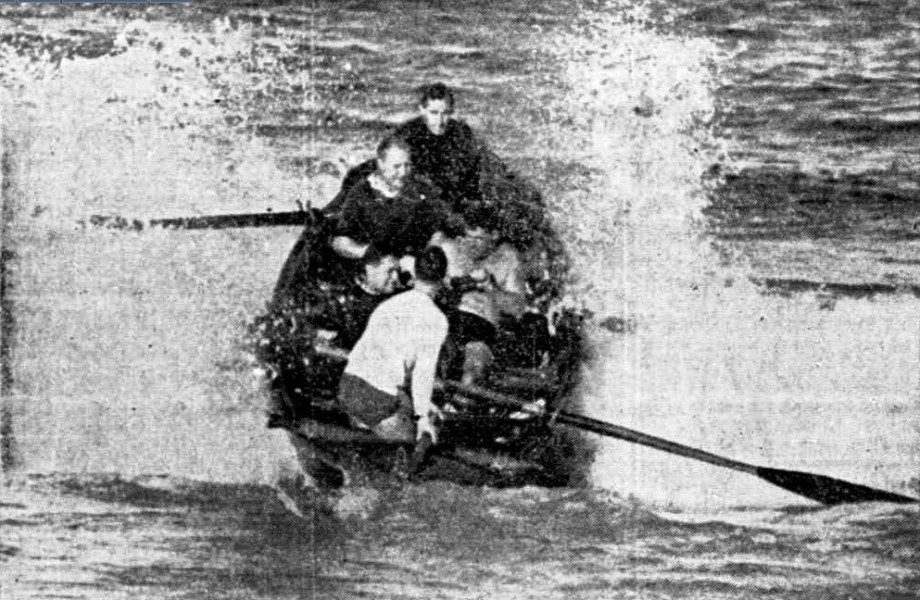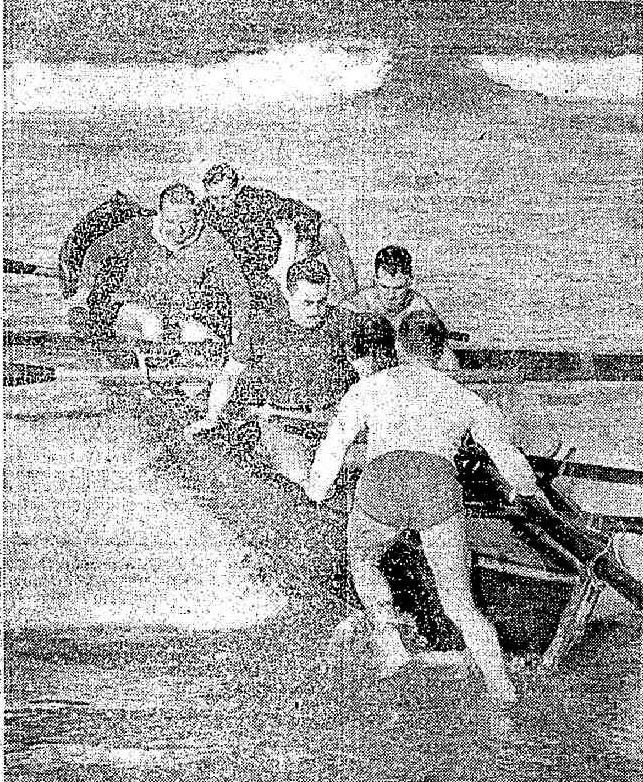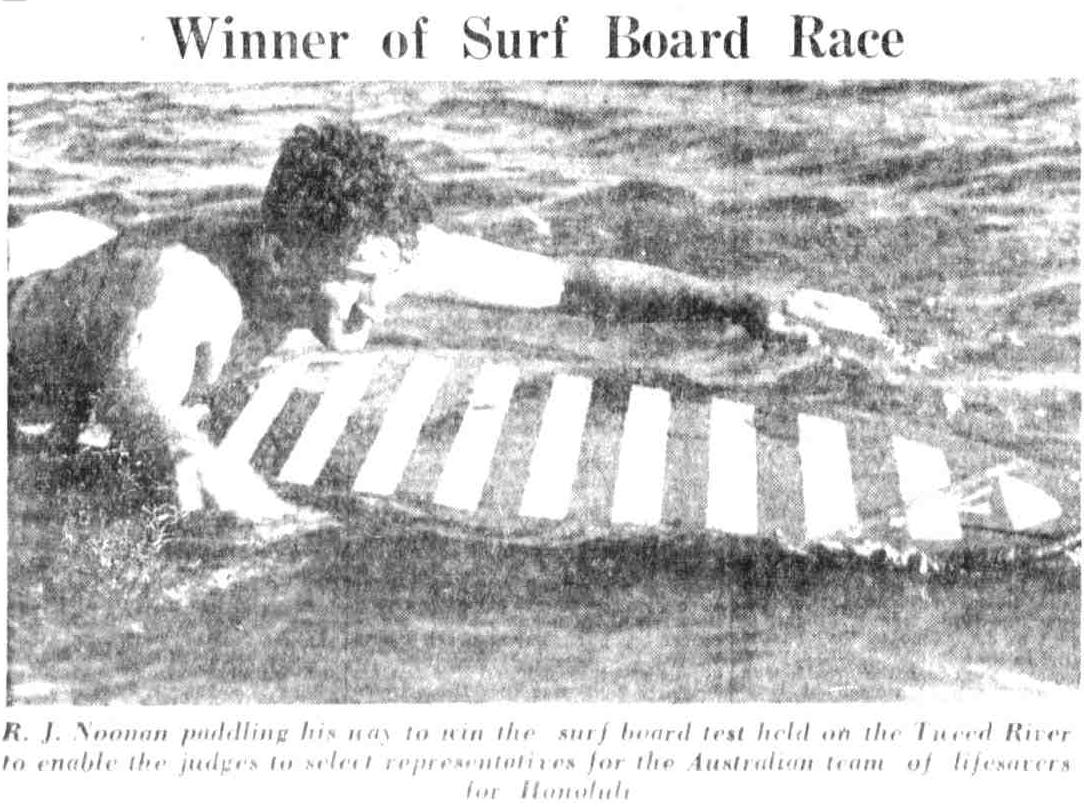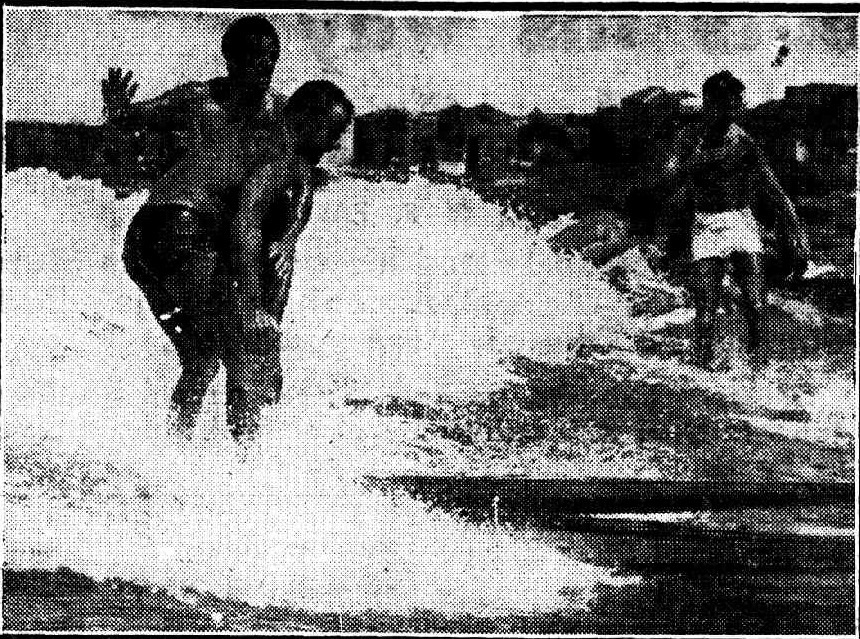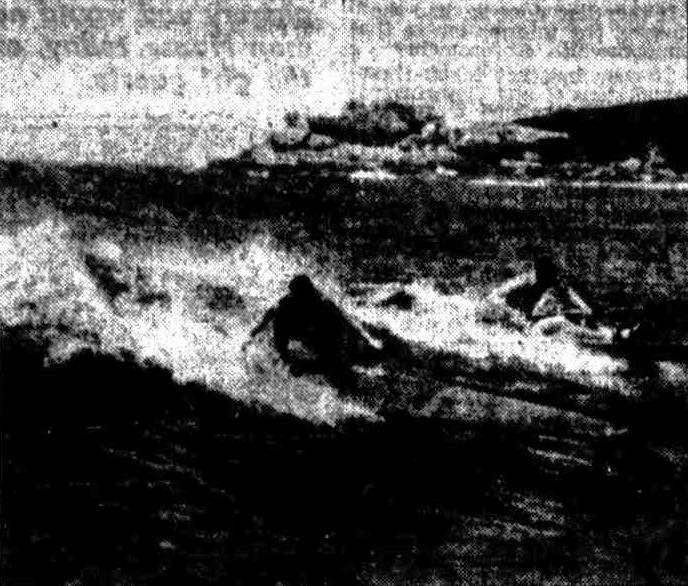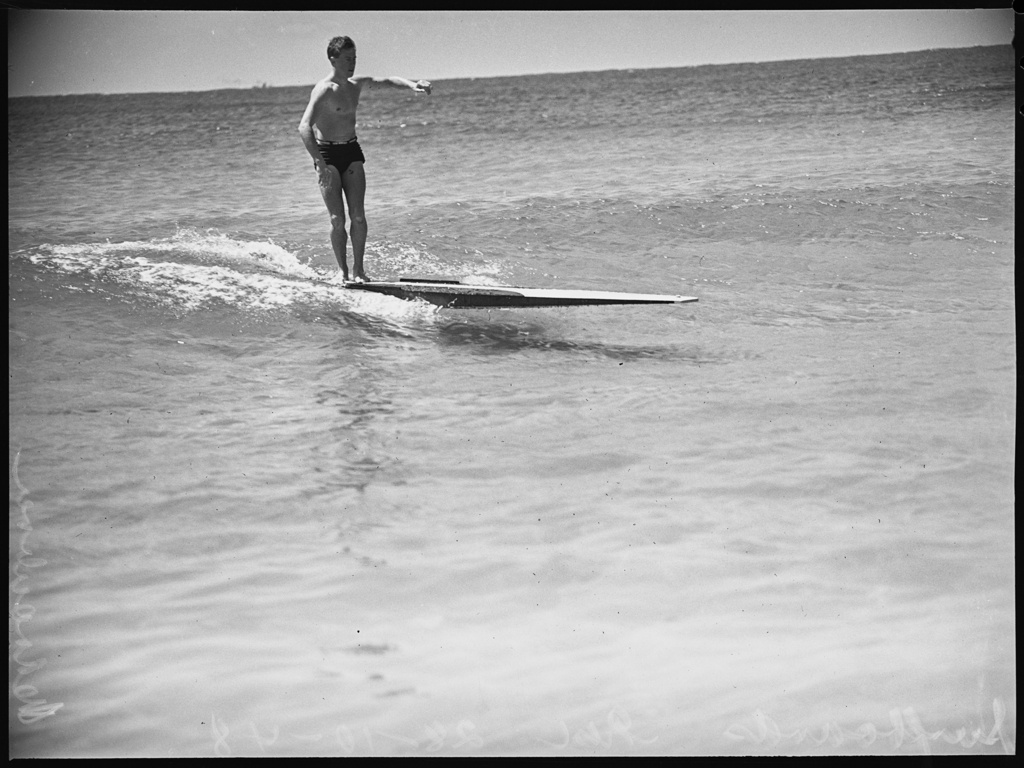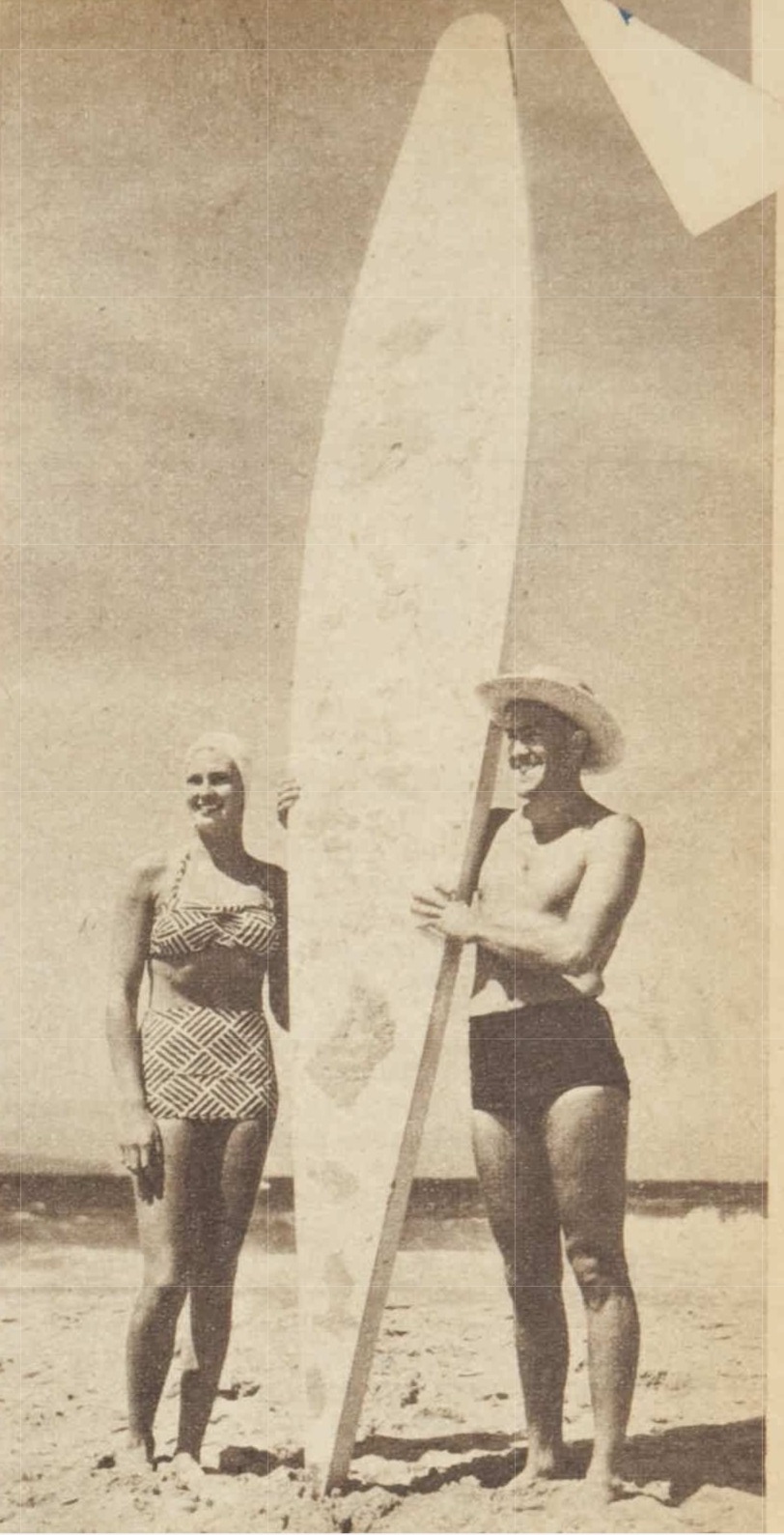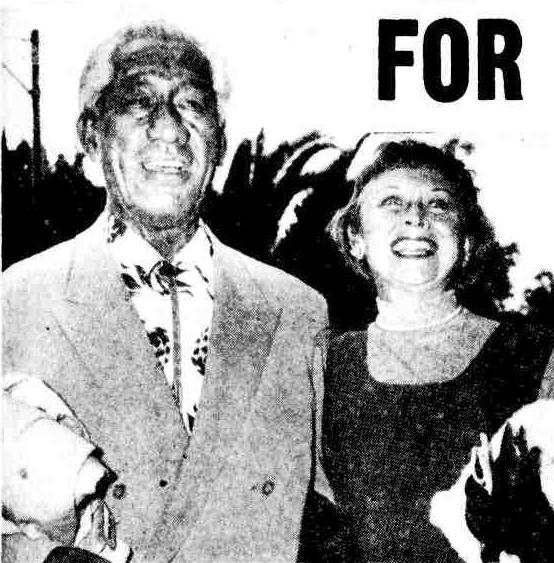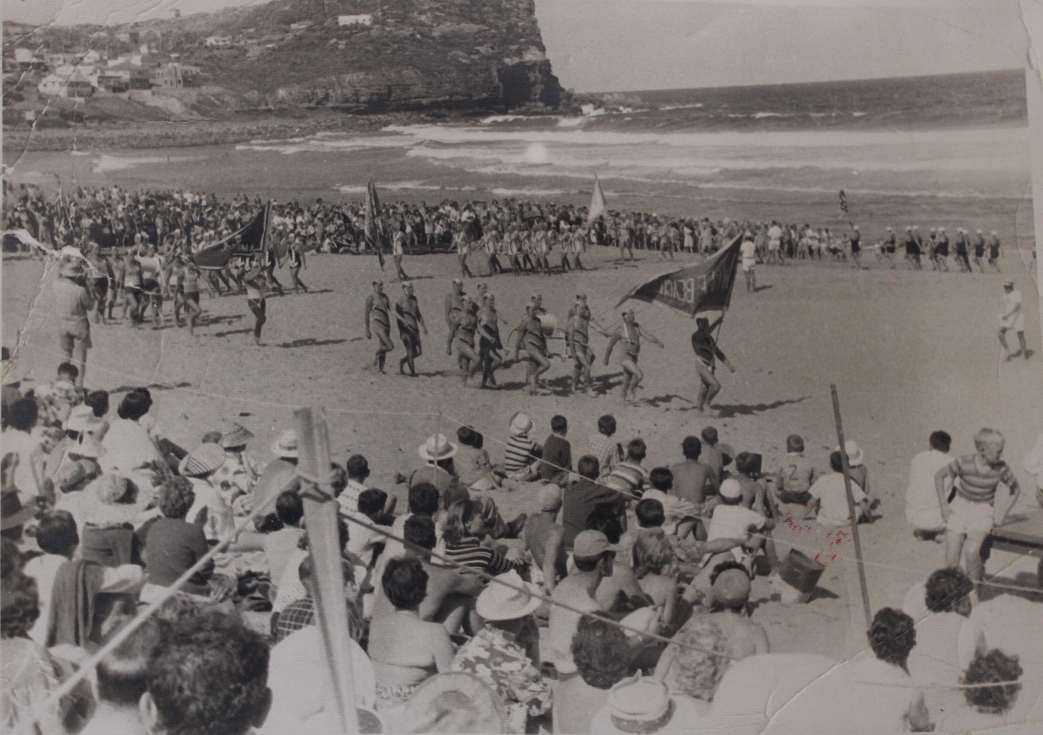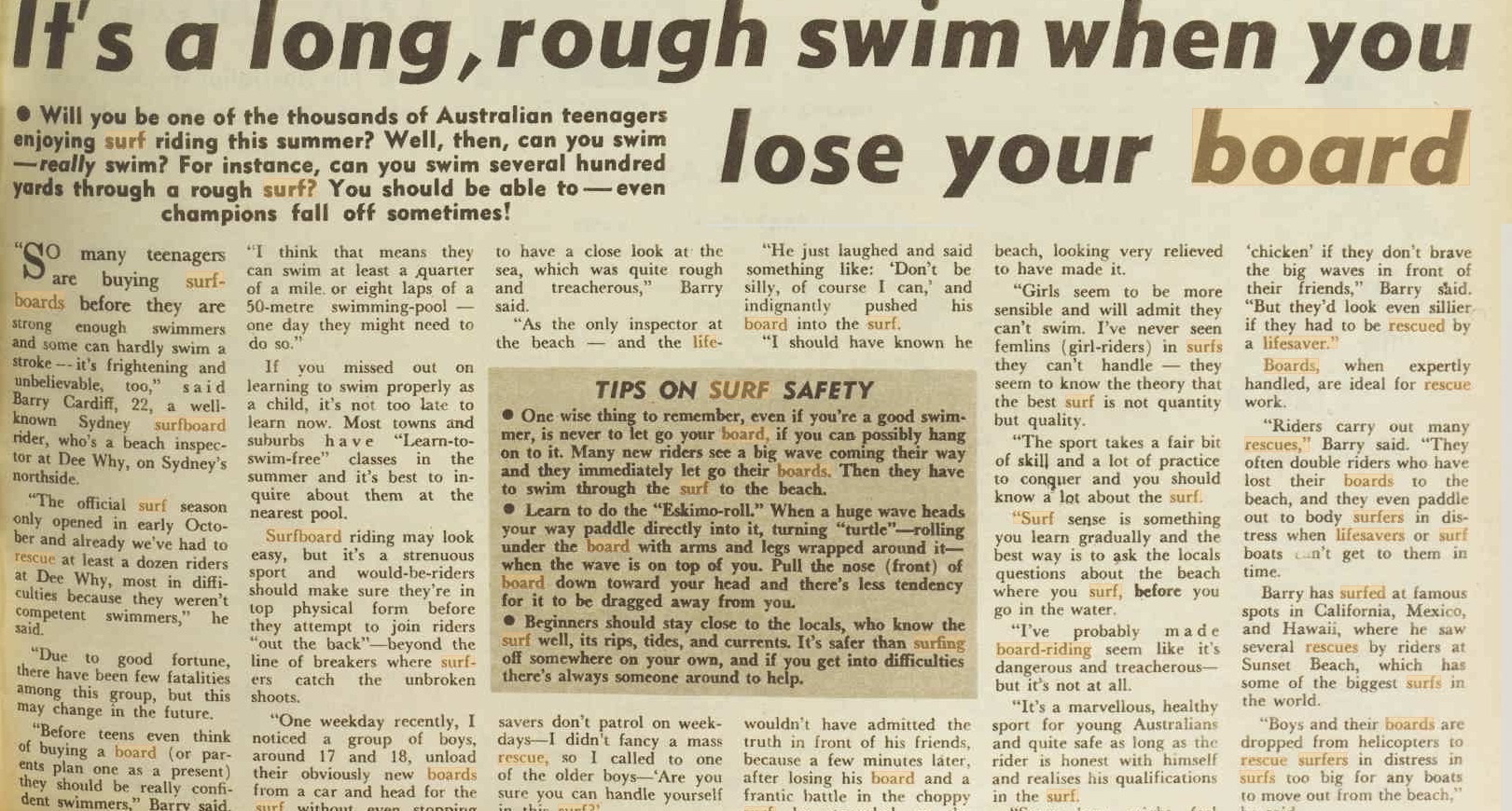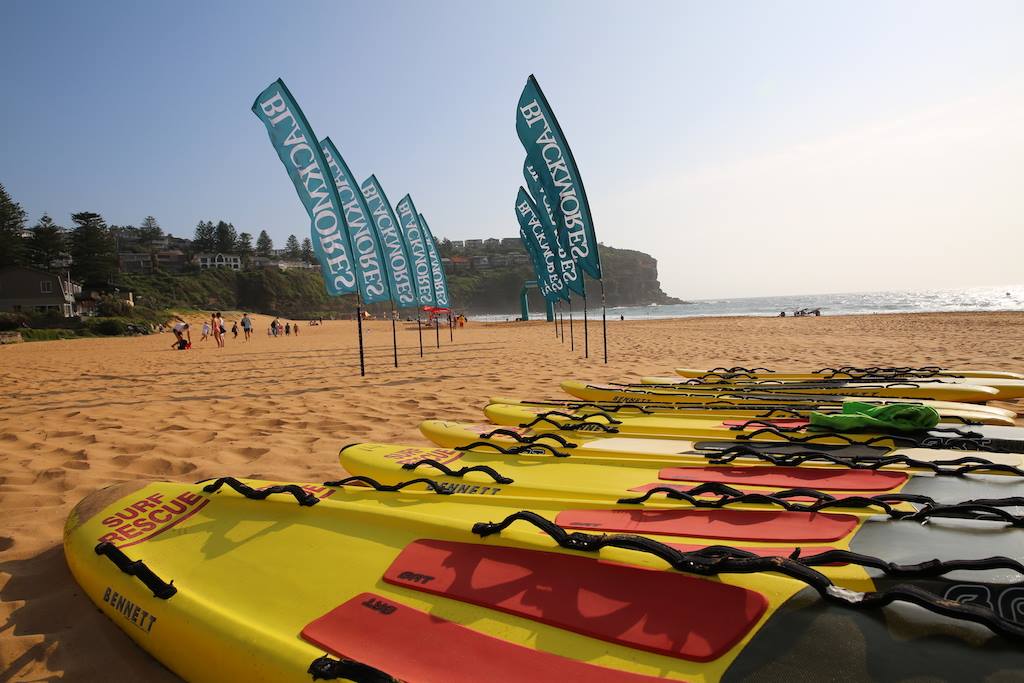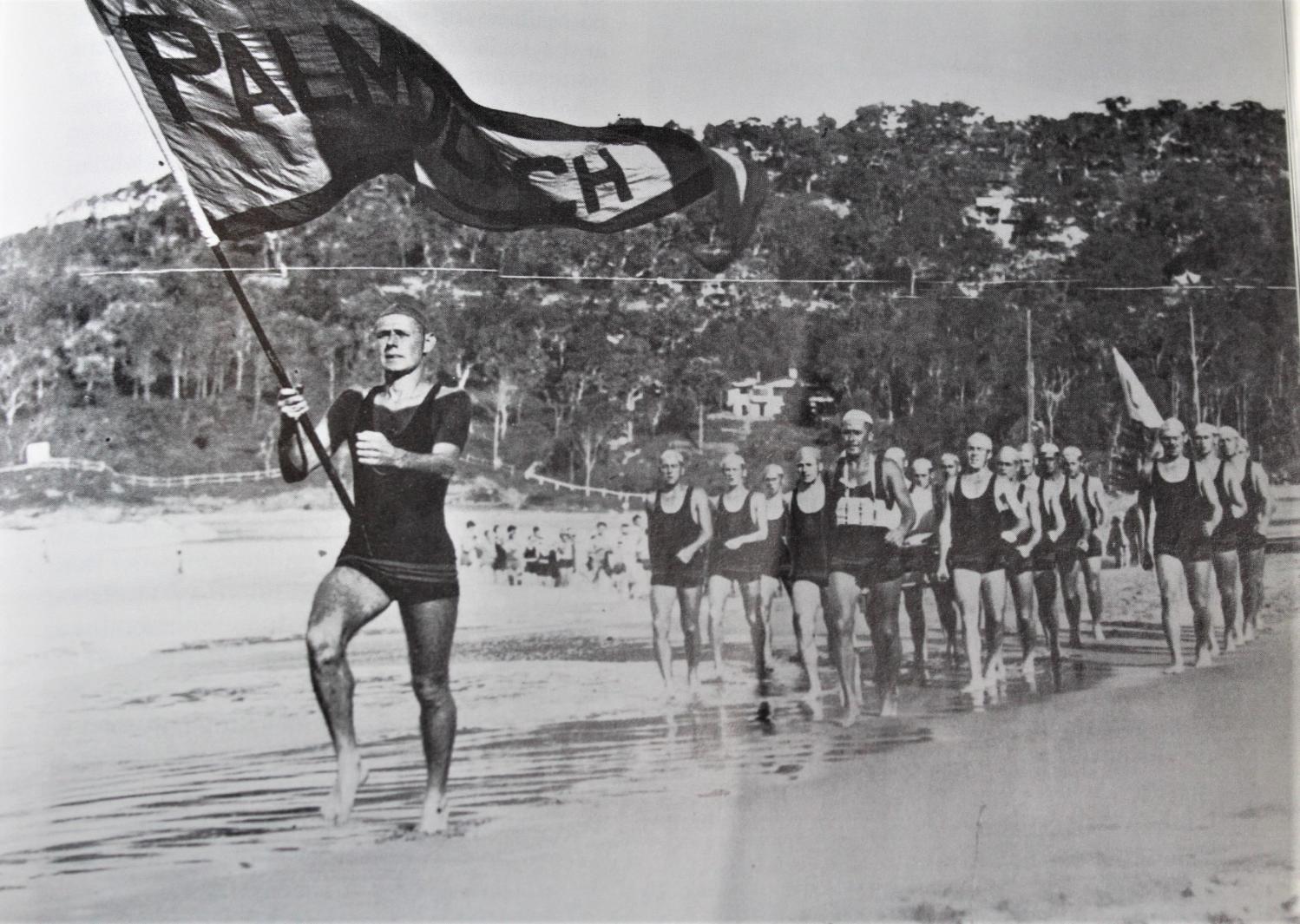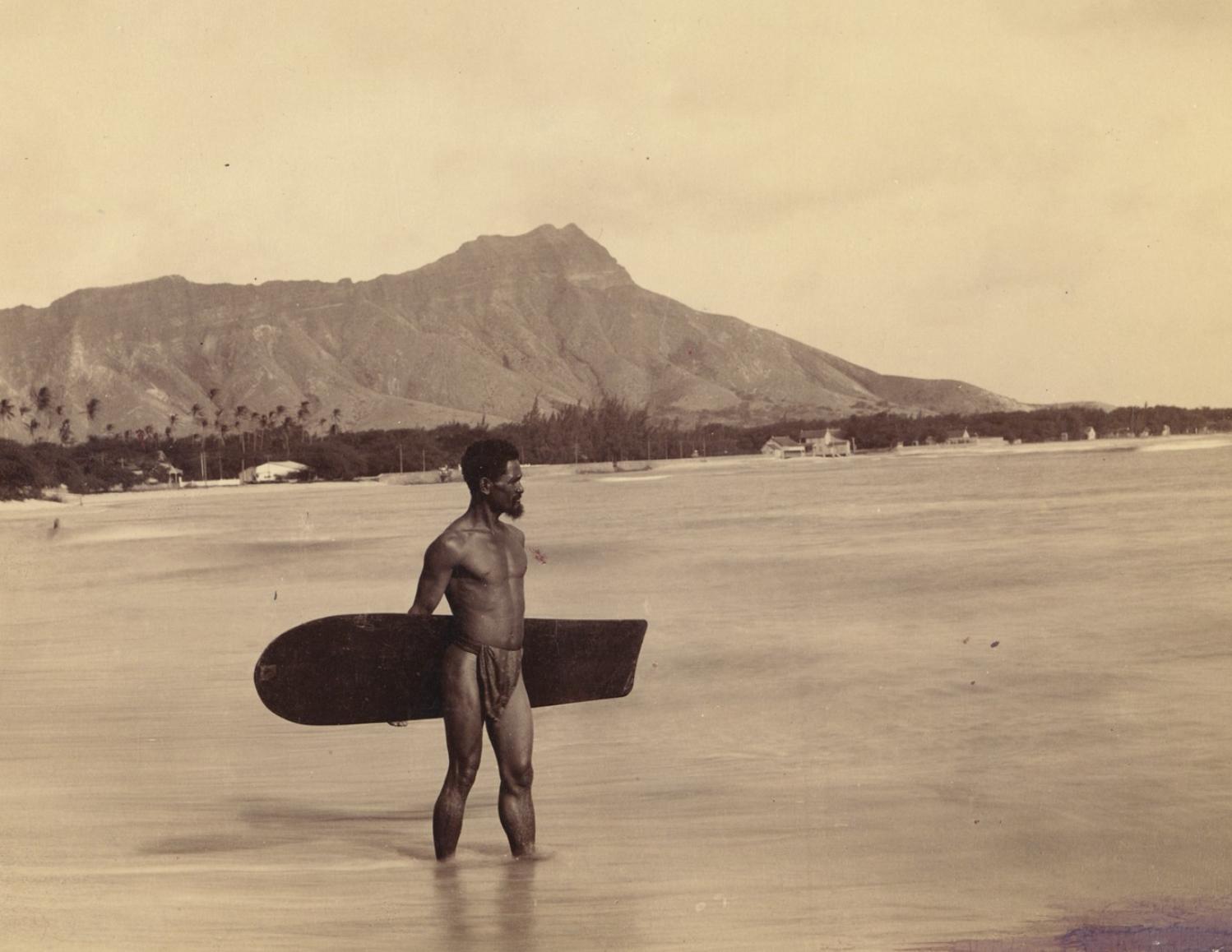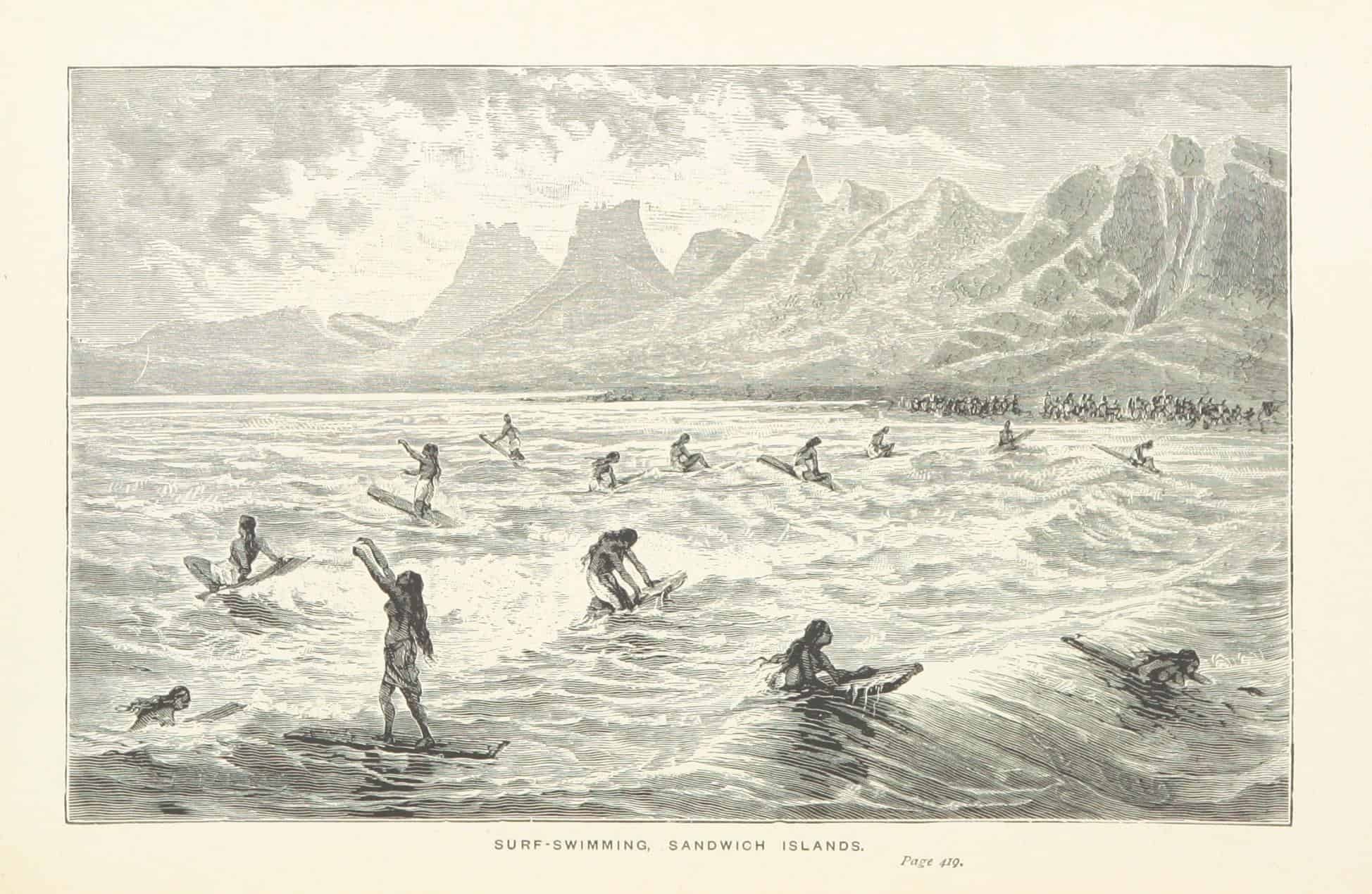The 2021 Surf Life Saving NSW Coastal Safety Report shows the surf board was used most in all rescues recorded in this report, Boards were used in 43% of rescues, followed by rescue tubes (21%) and IRBs (13%).
This is backed up by Surfing NSW, with support of the NSW Government, giving all surfers in NSW the opportunity to do a free CPR and Board Rescue Course – “Surfers Rescue 24/7”. Surfers Rescue 24/7 is a free CPR and board rescue course for any recreational surfer in NSW, WA and Victoria. Beach usage, whether for sport, recreation or competition, comes with inherent risk – the “Surfers Rescue 24/7” program aims to minimise this risk through the provision of free training to the NSW surfing community, with the next session coming up at Maroubra on December 4th, 2021.
The introduction of the board as a surf rescue equipment option can be traced to surfboard happy Palm Beach SLSC, celebrating its 100th year in the 2021-2022 Season, who had among their early membership John 'Jack' Ralston, credited with introducing the board to other members and friends and being the first to surf at Palm Beach in 1919, and Peter Hunter.
Palm Beach early 1930s L-R: C. Shaddock, Lister Ifould, Alrema Samuels, Rex Beale, E. Newman, Richard Mant, Herb Tattesall, John Ralston
Palm Beach 1930s. L-R; ?, ?, John Ralston, Richard Mant, Alrema Samuels, Herb Tattersall, R. Mant, possibly Lister Ifould, ?. Photo is owned by Nicholina Ralston.
Between 1926 and 1929 Palm Beach SLSC members had 16 boards stored at the clubhouse (due to their size and weight of up to 100lbs, with most made from solid American redwood). This surfboard tally was the then highest ratio of surfboard to surf lifesaver at a time when having one built was expensive - expensive to have the work done - then add some for delivery of something that big and heavy.
Riders who could surf without ending up 'in hospital due to same' could see the surfboard could be used in rescues - Manly Surf Club also calling for them to be used as a device for saving lives in the surf.
At Palm Beach it is
John Ralston to whom is attributed the first surfboard riding, possibly on a board obtained from Manly's Claude West:
Adrian Curlewis (later Sir) was, possibly, the second person to ride a surfboard at Palm Beach. Adrian learned surf-board riding from John Ralston, who had the first surfboard at Palm Beach.
Later he bought his own surfboard for £5.
"It had belonged to Manly swimmer Claude West, who put an ad. in the paper reading: 'Surfboard for sale. Owner in hospital through using same'," Judge Curlewis told me. - Judge Curlewis has grown up with the century (1951, February 3). The Australian Women's Weekly (1933 - 1982), p. 17. Retrieved from http://nla.gov.au/nla.news-article51595911
Adrian Curlewis, circa 1930 doing a headstand at Palm Beach - photo courtesy Philippa Poole, daughter of the 'Father of Surf Life Saving'
The story of surf board riding at Palm Beach commences at the other end of the peninsula, at Manly. There remains some contention as to whom brought a surf board here for use as surf life saving equipment, one recorded Surf Life Saving entry holding C D Paterson did as a surf life saving device in 1909, another that a Tom Walker did around the same time.
North Narrabeen can also lay claim to having early surfers among surf life saving members with Toby Hynard, a North Narrabeen SLSC member, apparently being taught board riding by the Duke while on a holiday to Hawaii and had brought a board back to Australia around 1911-12.
Australian legend of board riding, Snowy McAlister, also remembered someone from Narrabeen having a surfboard around that same time. Stan Exton, a pioneer and Life Member, always maintained that he brought the board to Narrabeen prior to 1915 and that he and his friend Toby used to share it. This is substantiated by a photo taken outside a cottage owned by Stan:
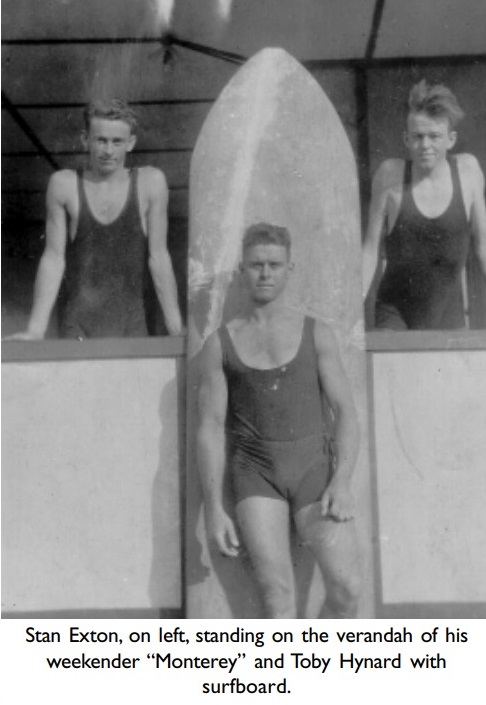
%20Tony%20Hynard%20surfboard.jpg?timestamp=1633629764832)
photos from and courtesy, The Beach Comes First, North Narrabeen SLSC history
This was followed by:
DUKE KAHANAMOUKU
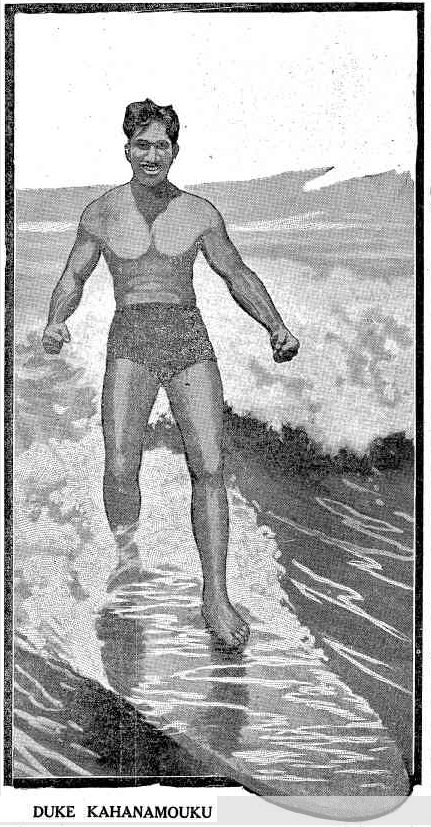
The marvellous Hawaiian, undisputed champion sprint distance swimmer of the world, some of whose natatorial feats are said to have astounded the fishes, as did the exploits of Pegoud, the French aviator, in the clouds, cause wonderment amongst the birds of the air. He is here seen performing one of his famous surfing accomplishments. This is not by any means his most daring achievement. Whilst dashing forward at an incredible speed, he stands on his head and does other things of an acrobatic description. Similar boards to the one he is shown using have been imported into Australia, but so far none of our surfing experts have been able to imitate his sensational deeds.
It is supposed, however, that the breakers that roll in on our shores are of a different formation, and not suitable for the purpose. All doubts on that subject would have been set at rest had Kahanamouku visited here this Summer, as was supposed to have been his intention. He has on several occasions expressed his willingness to come, but the time he originally offered to make the trip was regarded as inopportune by the officials of the Swimming Association who were carrying on the negotiations, and they fell through, owing to the date they suggested as a substitute clashing with the great water festival that is to be held at Honolulu on February 18 and 24 next. Visitors from all parts of the world have been known to go to Hawaii merely to witness Kahanamouku shoot the waves in the extraordinary fashion depicted above. DUKE KAHANAMOUKU (1913, December 14). Sunday Times (Sydney, NSW : 1895 - 1930), p. 20 (SUNDAY TIMES GLOBE PICTORIAL). Retrieved from http://nla.gov.au/nla.news-article126315151
And he following year, on Christmas Eve, Thursday December 24th, 1914:
SURF-BOARD RIDING.
KAHANAMOKU'S DISPLAY.
At the invitation of the NSW Amateur Swimming Association a number of newspaper representatives, accompanied some of the officials to witness an exhibition of surf-board riding by Duke Paoa Kahanamoku, the worId's champion sprint swimmer, at Freshwater yesterday.
It was Kahanamoku's first attempt at surf-board riding in Australia and it must be admitted it was wonderfully clever. The conditions were against good surf-board riding. The waves were of the "dumping" order and followed closely one on top of the other.
According to the champion, board-riding on the Waikiki Beach, Honolulu is a pleasure, and there it is possible to shoot well over a quarter of a mile. Then, too, Kahanamoku was at a disadvantage with the board. It weighed almost 100lb whereas the board he uses as a rule weighs less than 25lb. But, withal, he gave a magnificent display, which won the cordial applause of the onlookers.
Kahanamoku entered the water with the board accompanied by Mr. W.W. Hill and some members of the Freshwater Surf Club. Lying flat on the board and using his arms like paddles the champion soon left the swimmers far behind. When he was about 400 yards out he waited for a suitable breaker, swung the board round, and came in with it. Once fairly started, Kahanamoku knelt on the board and then stood straight up, the nose of the board being well out of the water.
But the force of the breakers never carried him more than 50 yards. On a couple of occasions he managed to shoot fully 100 yards, and then he cleverly demonstrated what could be done. He turned completely round, then, lying flat on the board, he raised himself on his hands and swung the board from front to back and back to front, finally again standing straight up. If the condition of the water is favourable when Kahanamoku makes his pubIic appearance in surf-board riding in Sydney it is sure to be keenly appreciated.
On February 6th, 1915, at Dee Why:
CARNIVAL AT DEE WHY
KAHANAMOKU ATTRACTS THOUSANDS
Deewhy had a day out yesterday. The local surf clubs annual carnival was on, but the big attraction was Duke Kahanamoku, who went down to show the natives how to ride the surf board. The board is as big as the bottom of a boat, and Kahanamoku went out so far on it that the crowd thought he was off to Honolulu. But about half a mile out he suddenly turned caught the breaker, and electrified the audience by kneeling, standing, and upending himself on the board, finishing up by diving a somersault when the breaker broke. On one occasion he disappeared. 'There goes his board, someone shouted. "Thats not his board, said someone else, "that's one of his feet." And so it was. Kahana, etc., kept up these stunts for an hour, and gave a great display. For part of the time he was accompanied by Miss Letham, of Freshwater, an Australian girl swimmer, who, it is said, only comes out of the surf to eat and sleep. On one occasion both swimmers stood riding the board for about two hundred yards. Duke received an ovation at the conclusion of his display. The crowd at the carnival was the biggest that had ever congregated at Deewhy since the inland aboriginals came down to spear fish in the lagoon and dance corroborees round their shell-fish heaps on Long Reef. About four thousand were present. There was a big programme, and the various events were spiritedly contested. The surfing and live-saving events were under the control of the N.S.W. Surf Bathing Association. The days sport was concluded with an open-air concert last night.
GRAND PARADE AND MARCH PAST. — Dee Why 1, Collaroy 2. THIRD ROUND (Metropolitan Division) RESCUE AND RESUSCITATION COMPETITION FOR 1915 CHAMPION-SHIP PENNANT OF SURF-BATHING ASSOCIATION OF N.S.W. — Bondi A, 57.77 points; Manly A, 57.49 points; Coogee, 56.66 points; North Steyne, 52.83 points; North Bondi, 50.29 points; Bondi B, 49.20 points. NOVICE SURF RACE. — H. V. Rein (Manly) 1, C. D. Bell (Manly) 2. COCK OF THE WALK. — First heat: Narrabeen beat Dee Why B. Second heat: Collaroy beat Balmoral. Third heat: Dee Why A beat Clovelly. Final: Dee Why beat Narrabeen. BEACH RELAY RACE. — First heat: Collaroy 1, Dee Why 2. Second heat: North Steyne 1, Dee Why 2. Third heat: Coogee 1, Narrabeen 2. Final: Collaroy (L. Chimchen, T. V. Smith, A. Sheldon, and L. Sheldon), 1 ; North Steyne (L. E. Goulding, G. Morgan, O. H. C. Merritt, C. W. Whitehead), 2. In this race a collision occurred, necessitating a re-run. The results given are of the re-run. ALARM REEL RACE. — First heat: North Steyne 1, Bondi 2. Second heat: Manly 1, Dee Why 2. Final: Manly (H. M. Hay belt, O. Mater, H. Buhl, S. Bennett, D. West), 1; North Steyne (L. V. Hind belt, F. E. Nicholls, B. McEwan, E. Goulding, N. Thompson), 2. COCKFIGHT. — Balmoral (J. Doudney and C. Walker), 1. SURF BRACE RELAY RACE. — Manly (J. G. Brown and N. Smith), 1; North Steyne (C. Healy and L. Solomon), and Bondi (J. G. Brown and H. Fletcher), dead-heat, 2. NOVICE ALARM REEL RACE. — First heat: North Steyne 1, North Bondi 2. Second heat: Coogee 1. Third heat: Bondi 1, Narrabeen 2. Final: Coogee (J. Leary, H. Mason, H. McLure, R. Harrocks, M. Ruben-stein) 2. WHEELBARROW RACE. — North Steyne (H. Nichols and F. E. Nichols), 1. CARNIVAL AT DEE WHY (
1915, February 7).
Sunday Times (Sydney, NSW : 1895 - 1930), p. 13. Retrieved from
http://nla.gov.au/nla.news-article120792408
However, Palm Beach SLSC, in supporter for years
Alrema Samuels, a daughter of writer Louis Becke, possibly lends a much earlier experience and insight into surfboard riding. Louis Becke (1855-1913) witnessed surfing in Polynesia several decades prior to this, and possibly even took to the water himself. He would later take his daughters to this place on a returning to Australia via New Zealand in 1908 - probably the first time Alrema went surfing, as an 11 year old.
Becke was in the Ellice Islands by 1880 (now Tuvalu) working with the Liverpool firm of John S. de Wolf and Co. on Nanumanga until the trading-station was destroyed later that year in a cyclone. In February 1881 he opened his own store in Nukufetau, where he married Nelea Tikena. Later in 1881 a shipwreck on Beru Island in the Gilbert Islands caused him to lose all he had; Becke then worked in New Britain and was in Majuro by November 1882. For the next ten years Becke moved about the Gilbert Islands, Ellice Islands, Caroline Islands and Marshall Islands acquiring a knowledge of the customs and beliefs of the islanders and meeting palagi traders and beachcombers that Becke later used his stories.
JUST as my wild-eyed, touzle-headed Gilbert Island cook brought me my early coffee and hard ship biscuit, Toria and Vailele, brown-skinned brother and sister peeped in through the window, and in their curious bastard Samoan said 'twas a glorious morn to fahaheke.
Now I had learned to fahaheke (use a surf-board), having been instructed therein by the youths and maidens of the village individually and collectively. And when you have once learned surf-swimming the game takes possession of your innermost soul like unto cycling and golf. So I said I would come, and instantly my young friends handed me in a surfing costume, a highly indecorous looking girdle of thin strippings of the leaf of the pandanus palm.
This I blushingly declined, preferring a garment of my own design; a pair of dungaree pants razeed from the knees down. Then, bidding me hurry up and meet the swimming party on the beach, Toria and his sister ran back to the village to attend early morning service, to which the wooden cylinder that did duty for a church bell was already summoning the people.
Now, in some of the Pacific Islands surf-swimming is one of the forbidden things, for many of the native teachers hold the sport to savour of the po uli – ie; of the heathen days - and the young folks can only indulge in the innocent diversion away from the watchful eye of the local Chadband and his alert myrmidons, the village police, among whom all fines are divided. But in this particular little island we had for our resident missionary a young stalwart Samoan, who did not forbid his flock to dance or sing, nor prohibit the young girls from wearing flowers in their dark locks. And he himself was a mighty fisherman and a great diver and swimmer, and smoked his pipe and laughed and sang with the people out of the fulness of his heart when they were merry, and prayed for and consoled them in their sorrow. So we all loved loane, the teacher, and Eline, his pretty young wife, and his two jolly little muddy brown infants ; for there was no other native missionary like him in all the wide Pacific.
The simple service was soon over, and then there was a great scurrying to and fro among the thatched houses, and presently in twos and threes the young people appeared, hurrying down to the beach and shouting loudly to the white man to follow. A strong breeze had sprung up during the night, and the long rolling billows, which had sped waveringly along for, perhaps, a thousand miles from beyond the western sea-rim, were sweeping now in quick succession over the wide flat stretch of reef that stood out from the northern end of the island like a huge table. Two hundred yards in width from the steep-to face it presented to the sea, it ceased, almost as abruptly as it began, in a bed of pure white sand, six feet below the surface of the water ; and this sandy bottom continued all the way from the inner edge of the reef to the line of coco-palms fringing the island beach. At low tide, when the ever-restless rollers dashed vainly against the sea-face of the reef, whose surface was then bared and shining in the sun, this long strip of sheltered water would lay quiet and undisturbed, as clear as crystal and as smooth as a sheet of glass ; but as the tide rose the waves came sweeping over the coral barrier and poured noisily over its inner ledge till the lagoon again became as surf-swept and agitated as the sea beyond. This was the favoured spot with the people for surf-swimming, for when the tide was full the surf broke heavily on the reef, and there was a clear run of half-a-mile from the starting-point on the inner face of the coral table to the soft, white beach. Besides that, there was not a single rock or mound of coral between the reef and the shore upon which a swimmer might strike with fatal effect if the danger were not perceived in time.
The north point was quite a mile from the village, and, the tide being very high, we had to follow a path through the coconut groves instead of walking along the beach, for the swirling waves, although well spent when they reached the shore, were washing the butts of the coco-palms, whose matted roots protruded from the sand at high-water mark. In front of us raced some scores of young children ranging from six years of age to ten, pushing and jostling each other in their eagerness to be first on the scene. Although the sun was hot already, the breeze was cool and blew strongly in our faces when we emerged from the narrow leafy track out upon the open strand. Then with much shouting and laughing, and playful thumping of brown backs and shoulders, Timi, the master of ceremonies for the occasion, marshalled us all in line and then gave the word to go, and with a merry shout, mingled with quavering feminine squeaks, away we sprang into the sea, each one pushing his or her surf- board in front, or shooting it out ahead, and trying to reach the reef before any one else.
And now the slight regard for the conventionalities that had been maintained during the walk from the village vanished, and the fun began ducking and other aquatic horseplay, hair-pulling, seizing of surf-boards and throwing them back shorewards, and wrestling matches between the foremost swimmers. The papalagi (white man), swimming between the boy Toria and a short, square-built native named Temana, had succeeded in keeping well in the van, when he was suddenly seized by the feet by two little imps, just as a sweeping roller lifted him high up. And down the white man went, and away went his surf-board shoreward amid the shrieking laughs of the girls.
" Never mind," shouted Temana, shaking his black curly head like a water-spaniel ; and seizing a board from a girl near him, and pushing her under at the same time, he shot it over towards me ; and then Toria, with a wrathful exclamation, caught one of the imps who had caused my disaster and, twining his left hand in her long, floating hair, pitched her board away behind him. This little incident, however, lost us our places, and amid the merry gibes of some naked infants who were in the ruck, we swam on in face of the slapping seas, and at last gained the edge of the reef, which was now alive with nude, brown-skinned figures, trying to keep their position in the boiling surf for the first grand " shoot " shoreward.
Between the lulls of the frequent seas the water was only about four feet deep, and presently some sort of order was formed, and we awaited the next big roller. Over the outer reef it reared its greeny crest, curled and broke with thundering clamour, and roared its mile-line length towards us. Struggling hard to keep our feet on the slippery coral against the swift back-wash, we waited till the white wall of hissing foam was five feet away, and then flung ourselves forward flat upon our boards.
Oh, how can one describe the ecstatic feeling that follows as your feet go up and your head and shoulders down, and you seem to fly through the water with the spume and froth of the mighty roller playing about your hair and hissing and singing in your ears ? Half a mile away lies the beach, but you cannot see it, only the plumed crowns of the palms swaying to and fro in the breeze ; for your head is low down, and there is nothing visible but a wavering line of shaking green.
Perhaps, if you are adept enough to turn your head to right or left, you will see silhouetted against the snowy wall of foam scores and scores of black heads, and then before you can draw your breath from excitement the beach is before you, and you slip off your board as the wave that has carried you so gloriously in sweeps far up on the shore, amid the vines and creepers which enwrap the sea-laved roots of the coco-palms.
Then back again, up and down over the seas, diving beneath any that are too high and swift to withstand, till you reach the ledge of the reef again and wait another chance. Not all together do we go this time, for now the swimmers are widely separated, and as we swim out we meet others coming back, flying before the rollers under which we have to dive. Here and there are those who from long practice and skill disdain to use a board ; for springing in front of a curling sea, by a curious trick of hollowing in the back and depressing the head and neck, they fly in before the rolling surge at an amazing speed, beating the water with one hand as they go, and uttering wild cries of triumph as they pass us, struggling seaward. Others there are who with both hands held together before them, keep them-selves well in position amid the boiling rush of waters by a movement of the legs and feet alone.
But, that day, to my mind the girls looked prettiest of all when, instead of lying prone, they sat upon their boards, and held them-selves in position by grasping the sides. Twice, as we swam out, did we see some twenty or thirty of them mounted slopingly on the face of a curling sea, and with their long, dark locks trailing behind them, rush shoreward enveloped in mist and spray like goddesses of the waves. Their shrill cries of encouragement to each other, the loud thunder of the surf as it broke upon its coral barrier, the seething hum and hiss of the roller as it impelled them to the beach, and the merry shrieks of laughter that ensued when some luckless girl over-balanced or misguided herself in the midst of the foam, lent a zest of enjoyment to the scene that made one feel himself a child again.
For two hours we swam out again and again to fly shoreward ; and at last we met together on the beach, to rest under the shade of the palms, the girls to smoke their banana-leaf sului of strong negro-head tobacco, and the men their pipes, while the younger boys were sent to gather us young drinking-coconuts.
And then we heard a sudden cry of mingled laughter and astonishment ; for, tottering along the path, surf-board under arm, came an old man of seventy, nude to his loins.
" Hu ! hu ! " he cried, and his wrinkled face twisted, and his toothless mouth quivered, " is old Pakia so blind and weak that he cannot fahaheke ? Ah, let but some of ye guide me out and set me before the surf then will ye see."
Poor old fellow ! Like an old troop-horse who dozes in a field, and whose blood tingles to some distant bugle call, the ancient, from his little hut near by, had heard our cries, and his brave old heart had awakened to the call of lusty youth. And so, earnestly begging the loan of a board from one of the swimmers, he had come to join us. And then two merry- hearted girls, taking him to the water's edge, swam out with him to the reef amid our wild cheers and laughter. They soon reached the starting-point, and then a roar of delight went up from us as we saw them place the ancient on his board, his knees to his chin, and his hands grasping the sides. Then, as a bursting roller thundered along and swept down upon them, they gave him a shove and sprang before it themselves one on each side. And, old and half blind as he was, he came in like an arrow from the bow of a mighty archer, his scanty white locks trailing behind his poor old head like the frayed-out end of a manilla hawser, his face set, and his feeble old throat crowing a quavering, shaking note of triumph as he shot up to the very margin of the beach, amid a roar of applause from the naked and admiring spectators.
Poor old Pakia ! Well indeed art thou entitled to this stick of tobacco from the white man to console thy cheery and venerable old pagan soul in the watches of the night.
What is most remarkable about the above is the recording of women surfing as part of the culture of these people and quite natural for them to do, something that would regress in later generations both here and around the world to the point where some women were harassed from surf breaks to the point of giving up surfing all together.
Australians had, in fact, been given an opportunity to see surfboards, or the then versions of them, at the 1888 Centenary of NSW Exhibition. In 1888 Lady Carrington presided over the Exhibition of Women's Industries in Sydney, held during October at Prince Albert Park, Redfern, housed in the 1870 Intercolonial Exhibition Building (demolished 1954). The Exhibition was the closing event in centenary celebrations with a motto of 'Patience, Work and God's Grace'.
It included a series of auctions, cooking demonstrations, lectures on food and temperance, concerts of singing and other music, dramatic performances, comedies and award ceremonies. The Exhibition opened on Tuesday October 2nd, with a ceremony performed by Lady Carrington and a 100-voice choir accompanied by the Permanent Artillery Band.
The Exhibition received praise. It was free to children, but notably too expensive for working class women. One newspaper correspondent commented that women touted their wares at the exhibition as if it was a common flea market. Nevertheless, it drew close to 3,000 people each day, and its net profit of £6,000 financed the Temporary Aid Society, which lent money to women in financial difficulty.
One SMH article records:
EXHIBITION OF WOMEN'S INDUSTRIES.
The principal attraction at this exhibition yesterday was the cut-flower display. The entries in all classes were numerous, and many of the exhibits reached a high standard of floral cultivation, and considerable artistic taste was shown in arrangement and decoration. In the sections for girls attending school there was a magnificent display of flower-baskets and table, hand, button-hole bouquets and floral devices. The arrangements in the annexe were excel- lent. Along the top were the loan exhibits, and the entries for competition were displayed below on the one side in turf and on the other among the foliage and greenery. The turf formed an admirable setting particularly for the roses, and enhanced the attractiveness of the department very considerably. The cottage gardening section showed up remarkably well in the class for the best 12 roses there were nine entries, for the best six 12, and for the best 12 varieties of cut ….
In Department I. Needlework and Lace, the Dutch goods from the Roman Catholic Orphanage at Rotterdam have been placed on exhibition. The articles include an infinite variety of needlework, including some miniature dresses, laces, and embroidery. Mrs. Monro, of Bathurst, has on view a satin patchwork embroidery screen, and Mrs. Bowker, of Darling Point, shows another screen of crewel work in satin, representing the four seasons. In one of the Centennial stalls in this department, is selection of native women's work from Samoa. The collection, which has been got together by Mrs. J E Newell, the wife of one of the missionary, includes, among other articles, a chiefs dress with belt, different garments, hats, and some specimens of coral.
On the opposite side of the central space a case is being erected by Mr. Hoffnung, for the display of a number of curios and valuable articles, which have been sent by the Hale Nana or Archaeological Society of Honolulu, for the Melbourne Exhibition Mr. Hoffnung has decided to show them at the present Exhibition before forwarding them on to Victoria.
Among the collection are the following; - Royal feather cape restored, feather bed quilt, cloak cape and two pillow cases, two native red and white topees, two native nuhau mats, dining mat, cocoanut wooden bowl, two stone idols, two wooden fish gods, taboganning sleigh for women, hair booth necklaces, round awa bowl, wooden plates, finger bowls, and spittoon, assorted sizes of wooden poi calabash belonging to a famous monarch, docs'-teeth ankle ornament, stone adze and side axe, rough unpolished adze, women's and men's stone poi powder, a stone mortar, with powder for medicine, stone dye containers, stone plate and lamp, an unpolished poi calabash, sting slug (an implement of war), ballot balls, a spear made of kanwila wood, pair of rough ti-leaf sandals, primitive telephone instrument, invented in 1806; a dancing and a small auxiliary drum, box of 37 tapa-pounders, carrier stick for bearing burdens, miniature single and double outrigger canoes, ornamented and unornamented water gourd, calabashes find unornamented spittoon calabash "for common people," textile fiber, scrapers and board of the olono, short war club, fine mesh net made of the olona, ball and twine of the olona fibre, bamboo flute, small nose flute of gourd and miniature native hut, wooden tapa blocks with rough samples of tapa, gourd dancing instrument, bundle of bamboo tapa prints, samples of native tapa clothes, Hawaiian checker board with white and black pebbles, the board perforated with small holes to designate the places of the pebbles placed as alternately white and black with holes throughout the board, and used as Kriege-spiel or war game board and diplomacy ; cocoanut wooden dagger, surf-ridding board and wooden hook. Hanging from the central dais is a magnificent Fijian mat made by native women. It has been presented to Lady Carrington by Miss Annie Buttel as a contribution to the Exhibition. In the afternoon Miss Waleen delivered in the concert hall the second lecture, "Kindergarten." The lecture proved a very interesting one and formed the complement of the one which was delivered on the previous afternoon. Mrs. Windeyer, the delegate for the Educational Department, presided. The German Band played several selections of music during the day. …EXHIBITION OF WOMEN'S INDUSTRIES. (1888, October 13). The Sydney Morning Herald (NSW : 1842 - 1954), p. 11. Retrieved from http://nla.gov.au/nla.news-article13699509
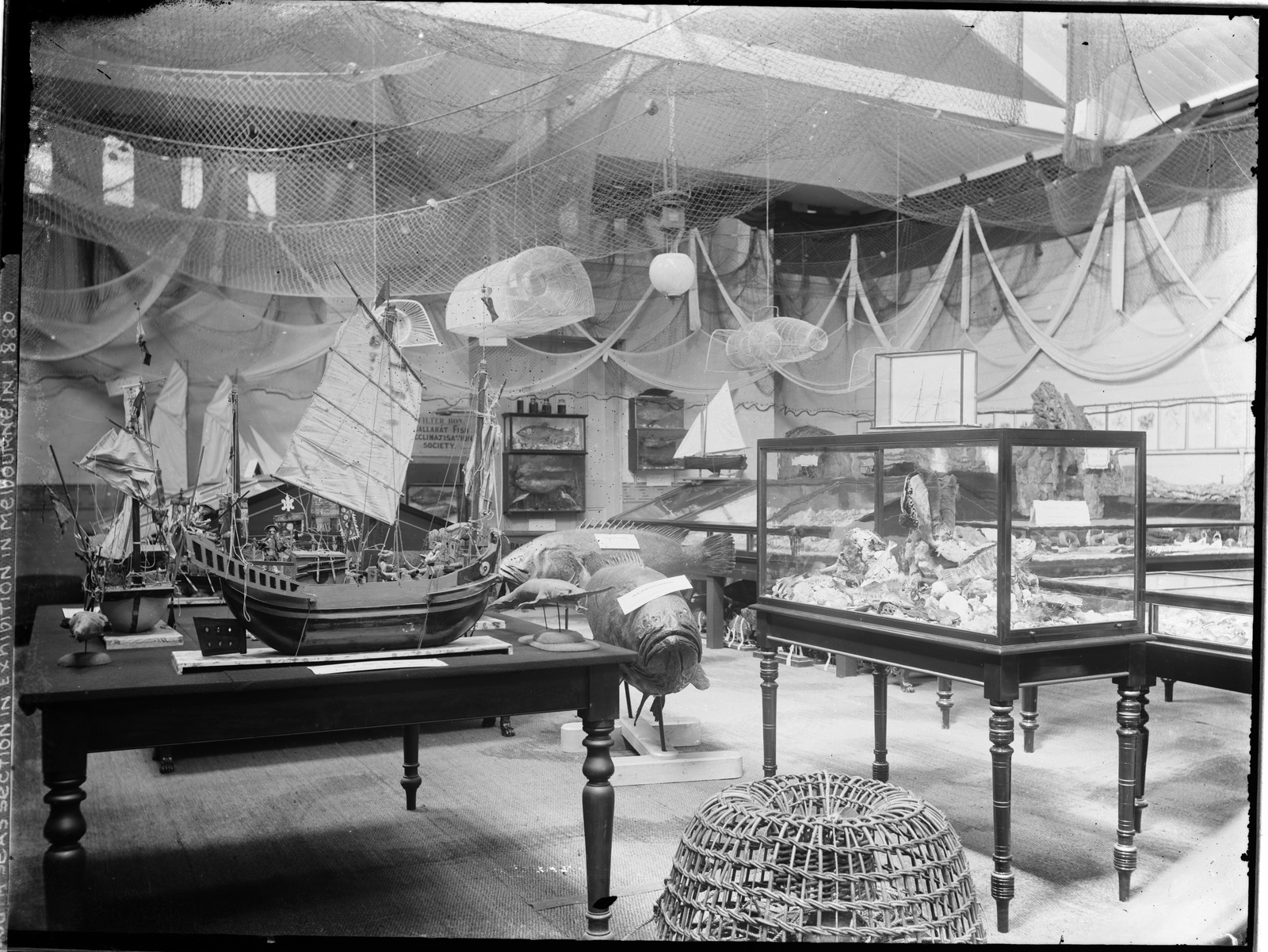
South Seas exhibition in Melbourne Centennial International Exhibition, 1888 - photo by Lindt, J. W. (John William), 1845-1926, courtesy State Library of Victoria. Item: FL15988655
Sydney Centennial Exhibition., 1888 - by Calvert, Samuel, 1828-1913, engraver. February 11, 1888. courtesy State Library of Victoria. Item: FL16416459
John Ralston and Peter Hunter were elected to a sub-committee to prepare a submission that would articulate Palm Beach SLSC's endorsement of surfboards as rescue equipment, their Surf Life Saving Australia submission stating the surfboard was ...'unequalled as a complete unit of surf-lifesaving...'
A sense of safety for those being rescued by being placed on something that floats, the speed the board can bring a patient back to the sand once a wave is caught, its granting of autonomy to the rescuer surpassed the reel and line, which could become entangled when swimming out and was limited by the reach of that line. Their report highlighted all these obvious facts and even included how a board offers some protection from sharks - John being able to recount, as well, how in Hawaii surfboards were, and had long been, the 'usual method of rescue'.
To further reiterate the club member's experience with the usefulness of boards, their 1930-31 Annual Report records a rescue being made during that season using a surfboard.
Trials at a pool followed and the SLSA thereafter recognised the surfboard as a piece of surf life saving apparatus in 1933, with board-riding a feature in that years' 'Aussies'. These articles show the surfboards then used:
TIDBITS OF CARNIVAL
A surfboard riding display Will be given by 33 experts at the surf championship carnival to-morrow. This will be the largest number of board men ever brought together on an Australian beach, and all are qualified members of various surf clubs. TIDBITS OF CARNIVAL (1933, March 17). The Sun (Sydney, NSW : 1910 - 1954), p. 2 (FINAL EXTRA). Retrieved from http://nla.gov.au/nla.news-article229054398
BOARDS CRACK LIKE PISTOL SHOTS as competitors throw them into the water for the surfboard and rescue race which are a feature of Australian beaches. The Camera Clicks -- And There You Are (1933, April 6). New Call (Perth, WA : 1931 - 1934), p. 24. Retrieved from http://nla.gov.au/nla.news-article210844069
Throughout our area the surfboard had been used by surf club members prior to becoming, officially, surf life saving equipment:
SURF LIFE-SAVING.
COLLAROY CLUB.
Collaroy Surf Life saving Club will hold its twenty first annual meeting on October 1 at 10.45 am Membership during the past year increased from 70 to 76 made up of 56 active, four active life, seven probitionatry and nine associate members...
Eighteen rescues were effected during the year, 11 being with the lifeline three with the surfboat and two each with surfboard and without a line ....SURF LIFE-SAVING. COLLAROY CLUB. (1933, September 27). The Sydney Morning Herald (NSW : 1842 - 1954), p. 18. Retrieved from http://nla.gov.au/nla.news-article17010226
This newspaper article reports how to use them:
SURF BOARD RIDING IS AN ART NOT AS EASY AS IT LOOKS - HINTS FOR BEGINNERS.
Often as we have sat comfortably on the beach watching a bronzed figure careering towards the shore on a surfboard, we have said enviously to ourselves. 'I wish I could do that.' It is not as easy as it looks. Surf-board riding is an art as the following article will show.
As C. J. McAlIister, the Manly board expert, said at the last Newcastle surf carnival, one must be 'brought up' with the board in order to be able to master the situations that arise.
The surf board has been given a place among life-saving equipment, and the following Instructions should materially assist those that are contemplating learning the art:—
(1) When placing the board In the water and taking it out through the surf, the nose must always be kept pointing directly at the incoming wav» —never side on.
(2) The rider should never force his way through the incoming surf. Use the channels where the tow is running the strongest.
(3) The position of the rider should be such as will maintain a correct balance, namely, body fully extended on the board, with feet and ankles overlapping the stern.
(4) The propulsion of the board should be; by. paddling with the arms simultaneously. The stroke should as long, deep, and as close to the board as possible.
(5) To avoid injury when caught by a' wave, ' always maintain a firm hold on the board.
(6) When meeting a large broken wave it is advisable for the rider to slip off the board and submerge, but a firm grip of the board must be maintained.
Newcastle has several expert surfboard riders. Including H. Scott, vice captain of Newcastle Club, E. Lambert; who won the surf-board exhibition against' the State's best exponents several years ago; C. Brown, T. Coloman and C.Sheriff (Coroba). SURF BOARD RIDING IS AN ART (1933, October 9). The Newcastle Sun (NSW : 1918 - 1954), p. 5. Retrieved from http://nla.gov.au/nla.news-article165077975
The surfboard was also being adapted and would become a lot longer and thinner, and a lot lighter with the invention of the surf ski. This description makes you wonder if her describing of what she had seen as a child helped facilitate its development:
Mrs. Alrema Samuels was one of the first people to try out the "Surf-ski," the new invention, at Palm Beach during the week-end. The surf-ski is part canoe, part surf board, and part ski, and promises to be a great favorite with surfers this season. The LIFE of SYDNEY (1933, October 25). The Daily Telegraph (Sydney, NSW : 1931 - 1954), p. 14. Retrieved from http://nla.gov.au/nla.news-article247174005
Left to right. Miss Sue Russell, John (Jack) Ralston PBSLSC with Alrema Samuels on right circa 1934-36 with 9 foot surfboard. Image No.: hood_02985, and below: hood_02978h. Titled 'Man and woman with 9 foot wooden surfboard' - Jack and Alrema again. Both courtesy State Library of NSW. One of Jack's boards similiar to this still features as a display at Palm Beach SLSC.
Seen at Palm Beach.
MRS. A. SAMUELS — quite the brownest of the fairer sex, and better than most men on a surf board. Social Sidelights (
1933, December 31).The Sun (Sydney, NSW : 1910 - 1954), p. 18. Retrieved from
http://nla.gov.au/nla.news-article230197599
This news item underlines that within a few years the waves at Palm Beach were getting crowded with both surf bathers and surf riders. A 'surf-o-plane' business had been allowed by the then council to set up on the beach. This lad was able to hire one, was knocked off it and swept out to sea.
His loss was the first fatality at Palm Beach, despite the efforts of R. M. 'Arthur' Stephens, Alan Major and Adrian Curlewis, and led the club to criticise the surfoplane and surf ski rental system- 'The occurrence again illustrates the danger of allowing inexperienced swimmers and bathers who cannot swim to use hired surf-o-planes and surf skis'.
The council instructed the manager of the hire business to not hire his craft out to the inexperienced:
SURFING MISHAP
SYDNEY, Monday.
In view of the hundreds who were surfing at Palm Beach on Sunday, Vivian Guest, aged 14 years, of Turrawa, north-west New South Wales, was knocked off a surfboard by a wave and drowned.
The boy went out on a surfboard about 1.50 pm when he disappeared, many surfers tried to find his body, but a choppy sea prevented a successful search. Guest was on holiday in Sydney, and was staying with his brother at Rose Bay. SURING MISHAP (1937, December 28).Daily Advertiser(Wagga Wagga, NSW : 1911 - 1954), p. 4. Retrieved from http://nla.gov.au/nla.news-article143667024
Palm beach [surfing with body boards], 31 December 1934. Image courtesy State Library of NSW, Item: SLNSW_FL19140780
The tragedy did not stop the hiring of such equipment. It did, however, spur lifesavers on to make better equipment to save people with, and raise their own standards in using the surfboard. Another Palm Beach SLSC member, then at the forefront of surfing and about to introduce the next innovation, was Reginald Keighly 'Blue' Russell, who likened Hawaiian waves to 'lying on a bed', possibly due to not having been among those huge swells Hawaii is famous for.
Reginald Keightley Russell, 'Blue' Russell, after studying the greater buoyancy and easier turning of the hollow surf skis, which some were using as surf boards (sans paddle) trialled and adapted his ideas to something that was much better than the heavy solid boards.
In 1937, after the collapse of his wool brokerage business went the way of many businesses during the Australian Depression, he could focus on designing these, with early models being built in a workshop under the clubhouse and tested in the nearby waves.
One of the most popular lads among the life-savers this year is "Blue" Russell, who, when not doing the most spectacular stunts on his board, is surrounded by young things on the beach. "Blue" is looked upon as the champion surf board rider among the crowd down there, with Pete Hunter and the Barnes boys close rivals. CATTY COMMUNICATIONS (
1938, January 1).
Smith's Weekly (Sydney, NSW : 1919 - 1950), p. 21. Retrieved from
http://nla.gov.au/nla.news-article234540875
BLUE RUSSELL built himself a hollow surf-board for the Bondi Carnival, and to uphold the honor of Palm Beach he has been practising round Elizabeth and Rushcutter Bays. THE JOTTINGS Ill (
1938, December 4).
Truth (Sydney, NSW : 1894 - 1954), p. 35. Retrieved from
http://nla.gov.au/nla.news-article169095748
Beach Beyond (page 63); 'It was claimed at the time that this Blue Russell board was the longest in the world. Standing with Russell (left) is his co-rider Elton Ifould (centre) and another admirer
Sean Brawley, in Beach Beyond - A History of the Palm Beach Surf Club 1921-1996, states his deep voice was often heard bellowing 'board wave!'
'PALM 'BEACH Comes Into The News AGAIN
WITH the official opening of the surf season last week-end, Palm Beach once more sprang into the news, and throughout Saturday and Sunday there was an endless line of cars taking picnickers down to this playground of the rich for their first surf of the season. To-day, if the weather holds, the same crowds will throng the beach, and a few of the holiday homes will ring with the gay laughter of young holiday-makers.
Sir Ernest and Lady Riddle, whose new and lovely bungalow has just been completed, have taken possession, and Sir Ernest Is starting his long holiday. He is photographed here with his daughter, Miss Enid Riddle, who is busy constructing a garden. His son, Mr. John Riddle, designed the bungalow.
Another home which has provided its owners with much happy recreation is that of Mr. and Mrs. Dan. Carroll, on Pill Hill. Theirs is perhaps the loveliest house at Palm Beach, with a view extending right across Broken Bay, Mr. Carroll is down for this week-end, but Mrs. Carroll will not go down till next. The Laurie Posters, who have become regular Palm Beach Identities, will not be down just yet, as Mr. Poster is in Melbourne, but should the past few days' heat continue, it will not be long before the gay parties of yore begin again.
The John Ralstons were down last Sunday and are planning to go down, to-day, but not to stay. Mr. Ralston's late father might be called a pioneer of Palm Beach and much of the success of the surf club belongs to the young couple. The Percy 'Spenders, who also figure largely in Palm Beach social news, are going down next week-end to their house, but this week-end they have lent it to Mrs. Spender's brother, Mr. Lawrence Henderson, and his wife.
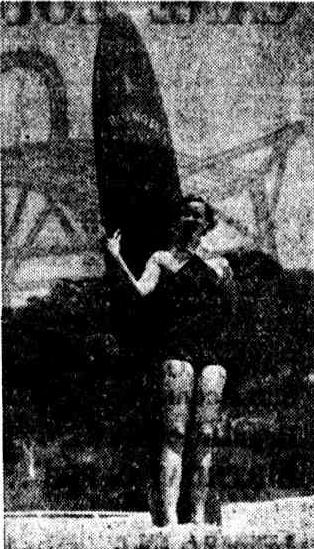
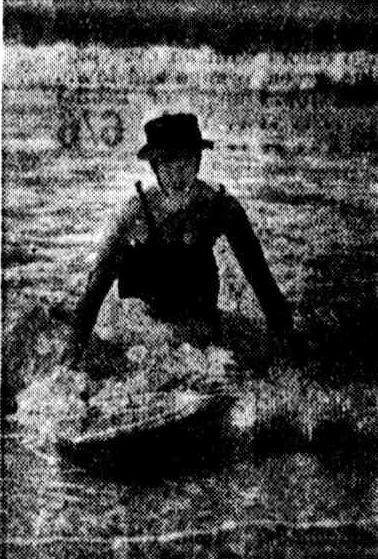 Mrs. Dallon, wife of Commander L. S. Dallon, is in the foreground and her small boy David, is under the umbrella.
Mrs. Dallon, wife of Commander L. S. Dallon, is in the foreground and her small boy David, is under the umbrella.
Mrs. C. E. Waters, who now lives at Palm Beach, is peeping from behind Mrs. Dalton. Her daughter, Naomi, now Mrs. Dalebrow-Bourne, is travelling on the Rhine with her husband.
Miss Margaret Allen, of Northwood, has spent the past month holidaying at Palm Beach. Her umbrella is a prized possession.
LEFT Miss Lulu Reichard, of Pymble, spends much lime at her family's seaside house, The Haven, at Newport, and frequently goes along from there to Palm Beach for surfing.
CENTRE A most picturesque figure in the surf at Palm Beach is Mr. Keighley (Blue)Russell, of Macleay-street, and his specialised surf hat.
Sir Ernest Riddle and his daughter. Miss Enid Riddle, admiring bottle brush on their new property at Palm Beach.
Mrs. W . R. Cox, of Collaroy and her sons, John and Brace, are frequent visitors to Palm Beach.
Mrs. Ken Jones and her young son Robert, of Lane Cove, are holidaying at Palm Beach.
PALM BEACH LETTER.
THIS week I am tempted to chat about the male element at Palm Beach and the clothes they are wearing. They say. 'When in Rome do as the Romans do,' but that is not so in Sydney, where what we hope are our men friends have gone all Hawaiian and all girlish as to beach wear. I know what we women would be called if we came out in dungarees and smoking pipes, and I think I know what lots of the men will be called if they persist in wearing light-colored shirts of flowered design, open at the neck, and green velvet shorts, and knotted silk scarfs, gaily colored and worn round the neck, which seem superfluous on men— THE MEN. at any rate.
It was quite a relief to see huge Blue Russell, in a normal bathing suit, dash Into the surf and rescue at least eighteen people who had gone out too far and were about to be drowned. Tiny Timothy Bell strolled down to the water's edge to meet Blue, and said, 'Nice work, Blue,' In his manliest tone. I think he Is about three. Last week-end produced heaps of 'trippers,' and among the picnickers were Mr. and Mrs. Noel Le Mestre Walker, whose party included Nancy Marcus Clarke and her fiance. Hal Cramsie and Goldie Grey were sun-baking a deux, and Graham and Jean Pratten were together, too. Enid Hull looked divine In her rubber swim suit, and her stalwart swain obviously thought so, too. A trio who looked enchanting and all dressed alike In royal blue satin bathers were Joyce Boynton, Betty Field and Peg Murray, but even so, I think Peg looks still lovelier in her white sharkskin suit with its scarlet cummerbund. Young men staying at 'Florida House' over the week-end were 'Pip' Reld, Clive Hall, Bill Dawson, Tom Porter, from Adelaide, and Reg Robson. They were manna from heaven to the 'she' house parties. The Lewis' Saturday night cocktail 'do' is rapidly becoming an Institution, and last week all the B.Y.T.'s went on from there to Pasadena for a night out.
Ludo and surf skiing are still first favorites, and young Michael York calls his surf ski 'over-she-goes.' Very appropriate, don't you think? The Riddles and the Lindsay Bells, who were entertaining the Philip Brownes, of Edgecliff, for the weekend, both had cheery 'drinkies' late in the afternoon. Arrivals and departures have been part and parcel of the week, and Dr. and Mrs. Cedric Swanton, of Darling Point, are newcomers. Last night's Anniversary Dance was grand — it was an excellent Idea limiting the invitations to 150, thereby ensuring a scramble Instead of a riot. There was lots of free beer — so the party weni with a 'bung.' Mild panic set In when a very young thing developed chicken-pox — but why worry? What's an epidemic more or less to Palm Beach?
Apparently Frank Packer insisted 'Blue' be part of this team:
HONOLULU WANTS SURF BOARD TEST AGAINST AUSTRALIANS
MEET AMERICAN CHAMPIONS HONOLULU. - Thursday.
Leading sportsmen here are moving energetically for a surf-board Test between Australian and American champions.
Among them is Sam Kahanamoku, who won a tandem surf-board paddling race, paired with Mrs Doris Duke Cromwell, here.
Doris Duke Cromwell is reputed to be the richest woman In the world. She Inherited £12, 000,000 from her father, James Duke, American tobacco manufacturer.
£400, 000 ESTATE.
Last month she came to live on her new £400, 000 estate in Honolulu. She is one of Honolulu's best women surf-board riders.
Sam Kahanamoku, one of Honolulu's best surf-board men, has visited Australia.
The move here for the international Test is being sponsored by the Honolulu Beachcombers Hui (club) of top notch Hawaiian and American ....(?) SYDNEY. Thursday.
A challenge has been received from Honolulu for Australians to match the skill of Honolulu surf-board men at Honolulu. Negotiations have been launched for an international Test at Honolulu this year
STOP-WATCH TESTS SPEED.
Tests against a stopwatch at Pittwater proves Australians could match the Americans in the Honolulu surf.
Mr Blue Russell, surf board expert, of Palm Beach Life Saving Club, discussing the proposed match said that surf-board experts have differed on whether Australians could match Honolulu men in their own surf.
The main issue has been whether Australians could paddle their boards as fast over a long distance.
"Paddling record times in the still water of a Honolulu canal, over distance from 100 yards to a mile, are held by Tom Blake, an American." said Mr Russell
"My tests, over the same distances. and in the harder water of Pittwater, showed just about the same times." he said.
Mr Russell was timed at Pittwater by Dr T. H Guthrie, of Whale Beach.
"I contend that Australians, their stamina toughened by our terrific seas, could match Honolulu men at paddling a board." he said.
"And their waves would be as easy for us as lying on a bed."
In the Pittwater tests, a light, hollow board, of special three- ply, about 16 ft 4 in., long. was used. This board was built by Mr Russell, who considers it as fast as boards used at Honolulu.
"It weighs about 30 lb.s whereas a solid board of that length would weigh about 200 lb," he said. HONOLULU WANTS SURF BOARD TEST AGAINST AUSTRALIANS (
1939, February 17).
The Evening News (Rockhampton, Qld. : 1924 - 1941), p. 3. Retrieved from
http://nla.gov.au/nla.news-article198300646
LONG RANGE FORECAST OF OLYMPIC TEAM.
Although the Australian Olympic team for the Games in Finland will not be selected for 12 months' speculators already are naming possibilities. The most likely to be selected have been' given out as follows: —
Athletes— Men: Ted Best (Vic.), sprinter; Brian Dunn, (N.S.W.), sprinter and broad jumper; Jack Mumford (N.S.W.), sprinter; Sid Stenner (N.S.W.), 120 yds. hurdles; Gerald Backhouse (Vic.), middle distance runner; Jack Metcalfe (N.S.W.), jumps. Athletics— Women: Decima Norman, sprint and long jump; Joyce Walker, sprinter; Isobel Grant, hurdler. Swimmers— Men: Percy Oliver (W.A.), back-stroker; Ron Masters (Vic.), diver; Robin Biddulph (NS.W.) , distances, Swimmers— Women: Irene Donnett (Vic.), diver; Pat Norton (NS.W.), back-stroker; D. Green (W.A.), free style, Cycling: Fred Ashby (Vic.), track rider; Bob Porter (N.S.W.), track rider; Gil Murray (Vic.), road rider. Rowing: Herbert Turner (N.S.W.), sculls; Herbert Turner and Cecil Pearce (N.S.W.), double sculls. Boxing: Les. Harley (Vic.), light-heavy; W, Smith (Tas.), middleweight; L. Wilson (NS.W.), bantam. ' Wrestling: R. E. Garrard '(Vic.), lightweight; R. Purchase (N.S.W.), featherweight; J, J. O'Hara (Vic.), middleweight. , The team will not be finally chosen until March of next year.
SURF BOARD CHAMPIONSHIP BETWEEN AUSTRALIA AND AMERICA.
Surf board skill is likely to be matched between champions of Australia and America in an international contest at Hawaii in July. The proposal (states Sydney Daily 'Telegraph') has been received with enthusiasm by the Surf Life Saving Association of Australia. A sub-committee has been appointed to suggest the means of finding the right men to represent Australia at Honolulu.
The famous Hawaii Beachcomber Club of American and Hawaiian University athletes is leading the movement for the international test. Among the prominent swimmers supporting it are Duke and Sam Kahanamoku and Marlechen Wehselau, former American Olympics, who have visited Australia, The proposal may become more .than a challenge between Australian and Honolulu surf-board men. Overtures have been. made from Honolulu to San Francisco and Los Angeles athletic leaders. It has been suggested that the contest might develop into annual Pacific Olympic Games. Whether this happens or not, the proposal for an International surf-board test in Hawaii includes a return contest In Australia next year.
Everyone wanted to go, of course, and trials were held for those who had the skills:
Testing Surf Men For Hawaii
Thirteen of Queensland's best life-savers gave demonstrations at Burleigh and Tweed Heads yesterday, in the hope of being selected .tor a team which will sail from Sydney on June 23. to represent Australia at an international surf carnival at Honolulu. How many, if any, representatives Queensland will have in the team will not be known until May 15 or 16, when the judges from Sydney, Mr. J. R. Cameron, chief superintendent of instruction and examinations of the Surf Life-saving Association of Australia, and Mr. T. Moran,. honorary registrar of the association, will announce their selections.When they have finished their work they will have examined 165 aspirants for the honour of representing Australia, but only 15 or 16 will be selected. SEA WAS CALM
The tests began on Burleigh Beach yesterday morning with a calm sea that gave little opportunity for real surf work. The competitors swam out 200 yards and back. R. Blow (Kirra) won from A. Imrie (Burleigh Heads and Mowbray Park), with G. Turpin (Burleigh Heads and Mowbray Parki third. The other competitors were T. Long (Burleigh Heads and Mowbray Park), W. Fleming (Kirra), and R. Roslan (Tweed Heads and Coolangatta). A belt race was won by Imrie, with Blow second, and Roslan third. Then six competitors gave a display of rescue and resuscitation, in which no order was announced. The Tweed Heads and Coolangatta Club's surf boat gave a demonstration before the judges. It was manned by J. Cranney (sweep). C. Phillip (stroke), D. Hargrave, W. Dalley, and C. Hargrave. In the afternoon an adjournment was made to Tweed Heads, where C. G. Englert and R. J. Noonan gave a display with surf boards.
HIGH STANDARD
Reviewing the day's work, Mr. Cameron said that the standard displayed by the Queenslanders was heartening, and illustrated the good effect of the policy of standardisation of life-saving work being carried out by the central body. Although invitations had been sent to the other States, Queensland was the only one, apart from New South Wales, to enter competitors. 'The team we have seen to-day could worthily represent Australia,' Mr. Cameron said, 'but we have 165 in all from whom to select our team, so. that we can only take the best.' Messrs. Cameron and Moran will leave Brisbane by air this morning, and will finish their examination of candidates on May 14, when they will test surf-board men on the Narrabeen Lakes.
The team, which will be accompanied by H. R. Biddulph, Australia's champion swimmer, will be the first to represent Australia outside the Empire. In February, 1937, Australia sent a team to New Zealand. Surf Men For Hawaii (1939, May 1). The Courier-Mail (Brisbane, Qld. : 1933 - 1954), p. 3. Retrieved from http://nla.gov.au/nla.news-article40858550
The team selected for Hawaii was printed in Volume 3 Number 10. June 1, 1939, page 14., of the Surf Life Saving Association of Australia: Surf in Australia.as follows:
J. R. Cameron (Captain-Instructor), H. R. Biddulph (Manly), C. R. Chapple (N. Bondi), R. Russell (Palm Beach), W. Furey (N. Steyne), L. McKay (N. Cronulla) , H. Doerner (Bondi), A. Imrie (Queensland), H. Scott (Newcastle), R. Dickson, W. Mackney and J. Harkness (Mona Vale), F. Braund (Palm Beach), F. Davis (Manly), A. Fitzgerald (N. Wollongong), L. Moreth (Manly).
'L. Moreth' was actually Clem Morath, of the Freshwater SLSC.
The item also stated:
'the R. and R. team for Hawaii is to be provided with military boots to race over the coral sea beds.' and 'Harold Spry, well-known Manly identity and ex-member of the Queenscliff club, will be visiting Hawaii at the same time as the surf team. Harold is an expert amateur movie photographer, and we hope he will be afforded all facilities to record the team's activities in film.'
They shipped per the s.s. "Monterey" on the 23rd June.
The July 1st Issue states:
Harold Spry, well-known Manly identity, has been appointed Hon. Photographer with the Australian team in Honolulu. It was surprising to see so many old surfers at the send-off, including Freddie Williams (the father of surf shooters in Australia), Neville Cayley, Les Duff, Roy Doyle, George Millar, Stan Windon, Geoff Cohen and others.
A few lines about the event:
At the final day's surf carnival at Honolulu the Australians defeated the Hawaii surf boat team by a length, while Russell would have won the surf board race but for having to swerve near the finish to avoid an opponent, and so came second. SPORTING ITEMS (1939, July 28). The Richmond River Herald and Northern Districts Advertiser (NSW : 1886 - 1942), p. 7. Retrieved from http://nla.gov.au/nla.news-article125943669
Surf Men In Action. Oarsmen in the Australian Surf Team take out a surf boat at Maroubra for a try-out. They leave for Honolulu on June 23 to compete at the Pacific Surf Games in July. Crew here is: F. Davis (sweep), J. B. Hardness (stroke), R. Dickson (3), G. Wray (2) (emergency who substituted for W. Mackney), F. Braund (bow). Surf Men In Action. (1939, June 18). Sunday Times (Perth, WA : 1902 - 1954), p. 3. Retrieved from http://nla.gov.au/nla.news-article59008010
SURF BOAT CREW.— F. C. Davis (Manly) sweep, J. B. Harness (Mona Vale) stroke. R. A. Dickson (Mona Vale) No. 3, W. A. R. Mackney (Mona Vale) No. 2, F. N. Braund (Palm Beach) bow. HITCH OVER SURF TOUR. (1939, May 17). The Courier-Mail(Brisbane, Qld. : 1933 - 1954), p. 16. Retrieved from http://nla.gov.au/nla.news-article40843003
Winner of Surf Board Race
R. J. Noonan paddling his tray to win the surf board test held on the Tweed River to enable the judges to select representatives for the Australian team of lifesavers for Honolulu Winner of Surf Board Race (
1939, May 1).
The Telegraph (Brisbane, Qld. : 1872 - 1947), p. 11 (SECOND EDITION). Retrieved from
http://nla.gov.au/nla.news-article185110952
Throughout the 1940's the sport and the use of the surfboard as surf life saving equipment spread, with many of these boards being built by surf club members and a Board Section for surf clubs being officially inaugurated on May 1st, 1945:
SURFBOARD MOVE
The Surf Life-Saving Association last night decided to form a surfboard section.
A special committee suggested that the section appoint its own officials and stipulated that members must be holders of the bronze medallion. It also recommended that surf-board carnivals be per mitted next season.
Commenting on the decision the secretary of the Australian Surf-board Association Mr D Hoinville said he approved of the scheme which showed that the Surf Life-Saving Association now recognised that such an organisation is needed. SURF-BOARD MOVE (1945, May 2). The Sydney Morning Herald (NSW : 1842 - 1954), p. 8. Retrieved from http://nla.gov.au/nla.news-article17939875
Surf-board "Glamor Boys" now ride to the rescue
By BOB GRAVES
One of the lifesavers who will use his board to patrol Sydney beaches this season.
THREE BONDI exponents on their feet for the high-speed thrill of a run to the beach. At this stage of board-riding a false muscular reflex will send the surfer tumbling sideways and his board careering madly out of control. But years of practice gives these men an uncanny sense of balance and a nerveless disregard of danger.
Once the toys of Palm Beach's aquatic play-boys, surf-boards will take an important part in Sydney beach rescues this summer.
More than 300 surf -boards will be used on Sydney beaches, from Cronulla to Palm Beach. For years suburban councils, beach inspectors, and surfers have regarded the skidding "planks" as a menace to body shooters. But this year they will save many lives.
The Surf Life Saving Association recently accepted affiliation of a Board Section, whose patrols will be rostered as a part of regular rescue work. The boardmen will be qualified life-savers and members of surf clubs. All beaches will have board-riders on patrol outside the breakers. A whistle or hand-signal from the shore will direct the riders to a "patient" in half the time it will take beltmen to battle through the waves. "Patients" will be supported on the boards and paddled to the beach. If the surf is too rough, "patients" will lie on the boards until the arrival of beltmen to take them in.
Dick Chappie, of Bondi, and Ray Leighton, of Manly, first suggested that boards should become official rescue units. Their requests were supported by Maroubra board veterans, Frank Adler and Roy Arkins. The Surf Association at first opposed this, but now the boards will be used for the benefit of the public, and body surfers will be prohibited from swimming in areas flagged for surfboard riding.
Old-time surfers recall board-riding in Sydney before 1914, when famous Olympic swimmer, Duke Kahanamoku used a hollow Hawaiian board. The Duke, who came to Australia to contest swimming titles, showed his amazing prowess on the board to Sydneysiders, and became better known for his board skill than for his swimming ability. At the time of Kahanamoku's visit, boards on metropolitan beaches were a rarity. Those who used them had clumsy, short, solid types. The riders' neck-to-knee costumes hampered their skill, and they had not reached the showy standing-up stage. They used to lie flat when riding waves.
Solid boards remained the vogue until the early the 1930's, although they improved in design. "Bluey" Russell, of Palm Beach, Lou Morath, of Manly, and Dick Chappie were then riding the "howlers" on long, tapering, solid boards. Sunbakers marvelled almost as much at their strength in carrying the heavy boards up the beaches as at their superb balance in riding them. Russell was unbeaten in races on his 20ft. board.
The first hollow board to take part in an official race was used by Sydney's heaviest board-rider, Frank Adler, at a carnival in 1934. Adler, who weighs 17 stone, found by experiment that a long, hollow board supported his great bulk comfortably. Fellow competitors laughed at his "queer" board, but respected it after he won the race by 100 yards. The speed at which Adler's powerful arms propelled his light board made his opponents look clumsy. Adler found that this new board could catch a green wave, while the solid boards wallowed in the troughs. Present Australian champion is 20-year-old Fred Knotting, of Manly. Knotting is called "The Beach comber" by fellow-surfers.
Amazing Speed
He invariably wears a ragged costume, and rides an old, hollow board that looks a wreck. Knotting relaxes until the start of a race, but the speed at which he paddles his board through the surf is amazing. He kneels (most riders lie flat), and his threshing hands throw great scoops of water behind like a paddle-steamer. Ray Leighton, who finished second' to Knotting last year, and Dick Chappie are regarded as Sydney's best and most spectacular boardmen. Leighton and Chappie have entertained thousands at Manly and Bondi for many years. Their nerve, skill, perfect poise, and balance are drawcards when a good surf is running. Surf Life Saving Association officials think board-riding will be the biggest attraction at coming surf carnivals. During the 1946-7 season, they expect a team of Hawaiians to visit Sydney. The following season an Australian team will compete at Honolulu. Surf-board "Glamor Boys" now ride to the rescue (1945, October 21). The Daily Telegraph (Sydney, NSW : 1931 - 1954), p. 28. Retrieved from http://nla.gov.au/nla.news-article248023556
It's Not All Glamor For The Surfboard Boys
By Bob Graves.
FIFTEEN years ago surfboard riding on Sydney beaches was considered a playboys' pastime; now the Surf Life Saving Association has taken official interest in it.
THE sport has boomed. More surfboards than ever before will appear on beaches this season, but they won't , all be used for pleasure. Most of surf clubs are now using boards as part of the standard rescue gear, and each patrol will have an experienced board-rider on hand in case he is needed for a long distance rescue. Club officials believe that boards will play a major part in rescues where the victim is washed hundreds of yards beyond the reach of lines. This was proved last season notably at Maroubra, where surf board Captain Frank Adler paddled 600 yards through huge seas to rescue a youth carried out on a rubber float, Adler's experience taught club officials at Maroubra and other open beaches where seas are big and rough, that the board is invaluable.
SO the Bondi, Maroubra, Cronulla and Palm Beach surfboard boys won't be all "glamor" this season. Many board riders may wear "glamor" trunks, but each club member will Have "his turn" on duty, and a board rescue in a big sea takes plenty of strength and courage. Getting through big broken waves and retaining a board is no joke. Experts say ' that the sudden popularity of ' surfboards, particularly among junior members, is due to modern designs.
Before the war, most board riders had to be hefty, strong-shouldered men. Some of the 16 foot boards of solid wood weighed more than 200lb. To catch a wave you had to start paddling hundreds of feet before the wave reached you In order to catch it. Few solid boards could ride a "greenback" or unbroken waves. Today, the design is sleek, ultra-streamlined and light. All boards are hollow, and the average 14-foot board weighs about 80lb.. Racing boards are not' much heavier than 30lb, and any can be hauled down to the water's edge by the slightest built man in the club.
CRACKING A WAVE. Surfboard rider and surf skier groove down a big wave.
DICK Chappie, of Bondi, was one of the first men to mass-produce hollow-boards. His example has been, followed by hundreds of amateurs and each surf club has its "board-builders". In several leading surf clubs', the builders have given up jobs and concentrated on manufacturing boards and skis. They are kept busy throughout winter months, and as most boards are made to suit the owner, they have a tough time with surf-club men checking each section of their board design.
Some old-time board riders would be surprised today to see slightly-built youngsters' picking up green waves hundreds of yards out without any great effort. The lightness and streamlining of the boards make it comparatively easy for an expert to get them moving quickly. You can even "chase" a wave and catch it.
BUT surfboard riding is not easy. It demands skill, balance, and above all, timing. Many experienced surfers cannot get that art of catching a wave at the right time, and 'on the right "angle." If you paddle too soon, the nose of the board "angles" into the water, and off you go. If you move too late, you miss the wave. If you stand up too early, you lose ,the wave, and if you are too late getting on your feet, the nose will dip and over you go. It is no joke when the board is travelling at approximately 25 mph and the nose dips. The board shoots back out of the water, and if you have not fallen, or dived forward, you can be seriously injured when the board, rockets back out of the water, and strikes you.
THE increasing popularity of boards, and surf skis, has led to many quarrels between riders and municipal councils. Boards have sometimes gone astray among surfing crowds, and bathers have been injured. This season, however, areas will be marked off for boards and skis. Swimmers will be chased out of the area, and most clubs will take strong action against riders who venture near the swimming areas. Majority of clubs have ordered handles to be attached to boards so, the rider can grab and retain it should he lose balance. It's Not All Glamor For The Surfboard Boys (1947, November 7). The Sun (Sydney, NSW : 1910 - 1954), p. 4 (STUMPS EDITION). Retrieved fromhttp://nla.gov.au/nla.news-article230564215
Surfboard rescue Maroubra - George Bishop National Board Championships, October 1948. Images Courtesy Mitchell Library, State Library of New South Wales and Courtesy ACP Magazines Ltd. Items SLNSW_FL9387581 and SLNSW_FL9387588
This type of surfboard remained the norm, with variations, into the mid 1950's:
SURFBOARD. Sun-tanned Mr. and Mrs. Ken Murrell, of Northwood, are among the keenest surfers at Palm Beach. Ken is a member of Palm Beach Surf Life-Saving Club. Holidays at PALM BEACH (1953, January 7). The Australian Women's Weekly (1933 - 1982), p. 7. Retrieved from http://nla.gov.au/nla.news-article39042660
And then something very different appeared. In 1956 a group of Californian life guards toured the east coast of Australia as a part of the Melbourne Olympic Games program. They brought with them their new light weight ‘Malibu’ surfboards. The Californians toured with the Malibu boards from Avalon Beach in NSW to Torquay in Victoria and in doing so redefined the future of Australian surfing.
In conjunction with the 1956 Melbourne Olympic Games, an International Surf Life Saving Carnival was held at Torquay Beach, Victoria. The competing countries included Great Britain, New Zealand, South Africa, Ceylon, and most significantly the Hawaiian and United States teams. The Hawaiian team also brought back to our shores surfing legend Duke Kahanamoku.
OVERSEAS LIFESAVERS
Teams of 12 American and 10 Hawaiian lifesavers have arrived in Sydney to compete in International surf carnivals in Melbourne and Sydney in the next month. They will be the first lifesavers from America or Hawaii to compete in surf carnivals in Australia.
The Americana and Hawaiians will appear at international surf carnivals at Torquay Victoria on November 25 and December 3, and at Maroubra and Collaroy, in Sydney, on December 8 and 9. They will compete against teams from south Africa, Ceylon. New Zealand and Australia and the belt champion of England.
Their first appearances in Australia were at carnivals at Cronulla and Avalon. The visit of the American and Hawaiian teams was made possible by the sponsorship of the managing director of Ampol Petroleum Ltd. (Mr. W. G. Walkley). With the exception of their captain, 45-year-old Herb Barthels, their ages range from 18 to 24. They are a team of young giants. The baby of the team is 18-year-old Roger Jensen, of Malibu beach, who is 6ft. 5 ins. tall and weighs 190 lbs. Their appearance in the march past at the international carnivals should cause a sensation, because they will wear the most striking three, colour parade costumes ever seen on an Australian beach. The trunks of the costumes will be a vivid red, the midriff white and the torso and shoulder straps a rich blue. On the upper front of the costumes will be the letters 'U.S.A' in red and white and two white stars. On the back of the costumes, against the blue background, will be five white stars.
Magnificent march past costumes have also been made to New South Wales for the Hawaiian team. Because the Americans are professional lifeguards, at the international carnivals they will compete only in events where life saving equipment is used. OVERSEAS LIFESAVERS (
1956, November 21).
The Biz (Fairfield, NSW : 1928 - 1972), p. 17. Retrieved from
http://nla.gov.au/nla.news-article189246779
THEY CAME FROM EVERYWHERE FOR OUR GREATEST DAY.
Their 8000 mile trip just failed. Duke of Hawaii smiles his way in. Beaming their delight, Hawaii's top personality, Duke P. Kahanamóku, and his wife (above)step smartly to their seats at the Games opening yesterday. A former Olympic Gold Medallist in the swimming ranks, Duke was a great friend-and opponent- of the late Sir Frank Beaurepaire, who did so much towards winning Melbourne the XVI Olympiad. ILLUSTRATED. THEY CAME FROM EVERYWHERE FOR OUR GREATEST DAY. (1956, November 23). The Argus (Melbourne, Vic. : 1848 - 1957), p. 9. Retrieved from http://nla.gov.au/nla.news-article71767378
The Carnival and after-carnival demonstration of boards that could turn on a wave was a sensation - those there report thousands witnessed their feats over the waves at south Avalon Beach and those who had built boards for themselves prior to this tried their hand at this new design.
The Sydney Morning Herald reported:
US Surfers Show New Technique. (Avalon)
Nearly 20,000 went to Avalon for the surf life saving carnival in which lifesavers from United States, Hawaii and New Zealand competed against Sydney clubs.
The American surfers, standing sideways on small 10ft. boards and moving at high speed, received a warm reception from the crowd.
One of the American surfers, Ted Levine (Tad Devine) had the opportunity to demonstrate his country's rescue technique in a genuine emergency.
Instead of the Australian belt and reel, he used a "torpedo buoy'. Thousands Throng Beaches: Many Saved. Sydney Morning Herald. Monday 19 November, 1956. Page 3.
Surfers To Sell Boards
The visiting Hawaiian surfers will sell their seven lightweight surfboards, which created a sensation at Avalon last Sunday, after their farewell appearance at Collaroy on December 9.
The boards, which are made from balsa reinforced with two two long strips of redwood and coated with a thick layer of fibre-glass, weigh 26lb.
The lightest racing boards in Sydney, made from 1/2 inch plywood weigh from 33 to 23 lb.
The Hawaiian boards, which have been used at Waikiki Beach for seven or eight years, can be made in less than a week.
Shorter, Wider
They are eight feet long, compared with the average Australian length of 16 feet, but are about five inches wider than the local board's 20-21 inches.
Three hundred people saw the Hawaiians give an exhibition of board riding after a special carnival at Avalon in a big surf last Sunday.
Unlike Australian boardriders, the Hawaiians stood on the middle of their balsa boards, even when heavy white water from the broken waves swept around their feet.
Harry Shaffer, captain of the Hawaiian squad, said last night of the boards : "There is no question of selling out to the highest bidder.
"We plan to give our boards to the fellows we consider to be the real enthusiasts at only a token cost." Surfers To Sell Boards. (Wednesday 21 November, 1956. Page 15) Sydney Morning Herald
Avalon Beach SLSC Carnival Sunday, 18th Of November, 1956 - March Past - Whale Beach, NSW, Australia leads visiting American team (courtesy
Beryl and Don Imison) - who also witnessed the display
Surf Life Saving introduced Racing Malibu’s to the Australian Titles in paddle board races and iron man competitions in 1962. The popularity of the new Malibu boards with Australia's teenagers also caused a greater need for rescue boards:
It's a long, rough swim when you lose your board (1964, November 25). The Australian Women's Weekly (1933 - 1982), p. 99. Retrieved from http://nla.gov.au/nla.news-article48517842
Locally Bennett Surfboards have been making paddle board and rescue boards for Surf Life Saving for over 40 years, as have a number of other manufacturers, although many local clubs prefer the Bennett board and supporting this Brookvale original.
They have been developed to more be hardier, more lightweight and now have handles to grab old around their circumference and knee pads. They also come in full size and a three-quarters length size.
At the 2019 Bilgola Beach Ocean Swim - photo by Rowan Jacobs
The rise in its use as rescue equipment is understandable - you can quickly grab a board stationed on the beach and get out to someone needing help and give them something to hold onto or get aboard while they are brought back to shore. The relief is immediate. The Sydney Branch of SLSA states the rescue board, manned by a skilled and experienced lifesaver, provides:
- A fast and reliable means of reaching patients
- Efficient flotation so that EAR can be commenced in the water
- Support for a number of persons in the water
- Confidence to a patient who has been placed on a craft
- A reliable means of returning a patient to the shore quickly and safely
- In the event of a group or mass rescue, a board or ski will keep a number of people afloat while supporting rescue operations are put into effect.
Rescue craft should be placed along the beach in strategic locations, ready for use in an emergency and clearly visible at all times. Surf clubs carry an adequate number of rescue boards to ensure efficient operations on their beach. In a board rescue, the lifesaver approaches the patient from the shore ward side and directs the patient to reach across and take hold of the hand grips. Grasping the patient’s leg, they pull the patient onto the craft and position them on the front of the board.
Returning to shore, the lifesaver remains in control of the board, behind the patient in a position between the patient’s legs. An experienced lifesaver will wait for a lull in the surf and use broken waves to speed up the return to shore.
Unconscious patients are secured by the wrist and rolled onto the board. Maintaining the grip on the patient, the lifesaver will then reach over and grasp the rail of the board and roll once again to bring it right way up and move the patient across the deck of the board. In a similar fashion to a conscious patient, the lifesaver mounts the board and completes the rescue.
To close we return to where this all stemmed from and a Branch carnival held at the Steyne during the summer of 1931 which records:
Very Fast
Another of the smaller clubs won a first prize when Tom Guthrie, of Palm Beach, surf-boarded cobber 'Pete' Hunter to victory in the first Surf Board Rescue Event held.
This was a most interesting contest, and the pace with which the boards were urged through the heavy seas to the patients at the buoys was an eye opener.
It certainly showed beltmen a point or two in speed.
Results....
Surfboard Rescue Event: T. Guthrie and K. Hunter (Palm Beach). 1.
Rings Run Round Empire Champion Ryan in Rough Race (1931, December 13). Truth (Sydney, NSW : 1894 - 1954), p. 9. Retrieved from http://nla.gov.au/nla.news-article169123631
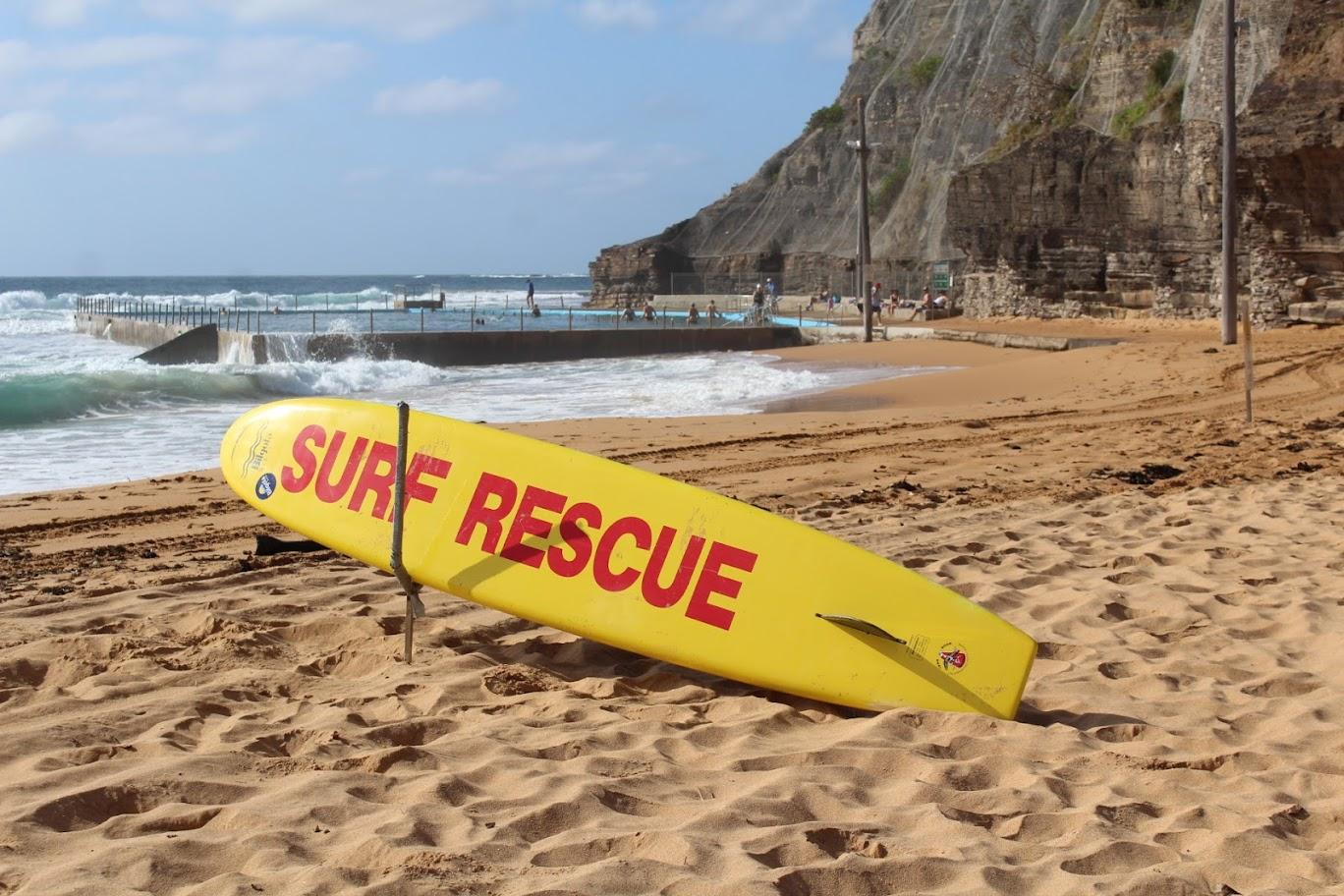
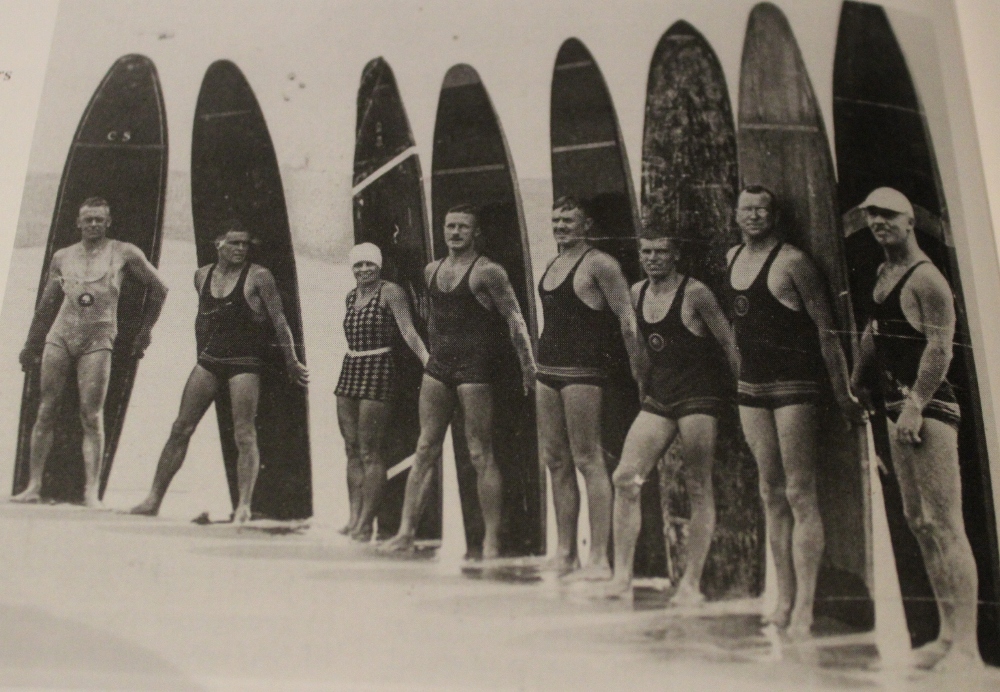
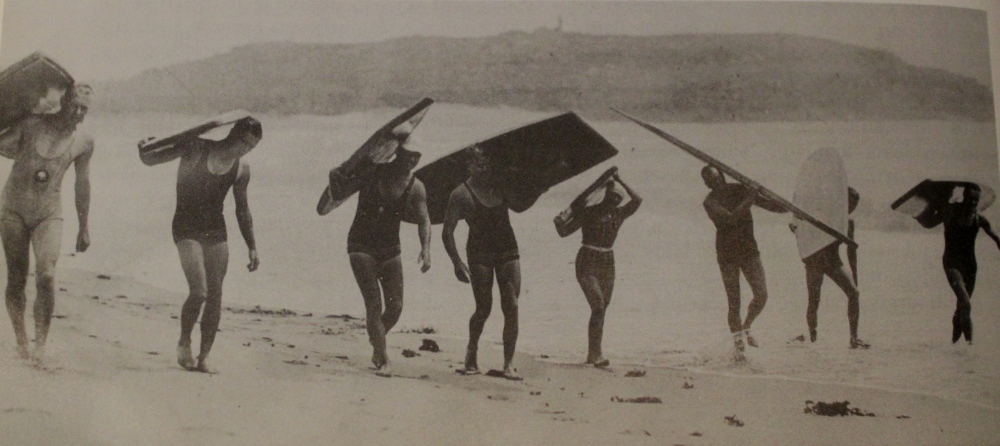
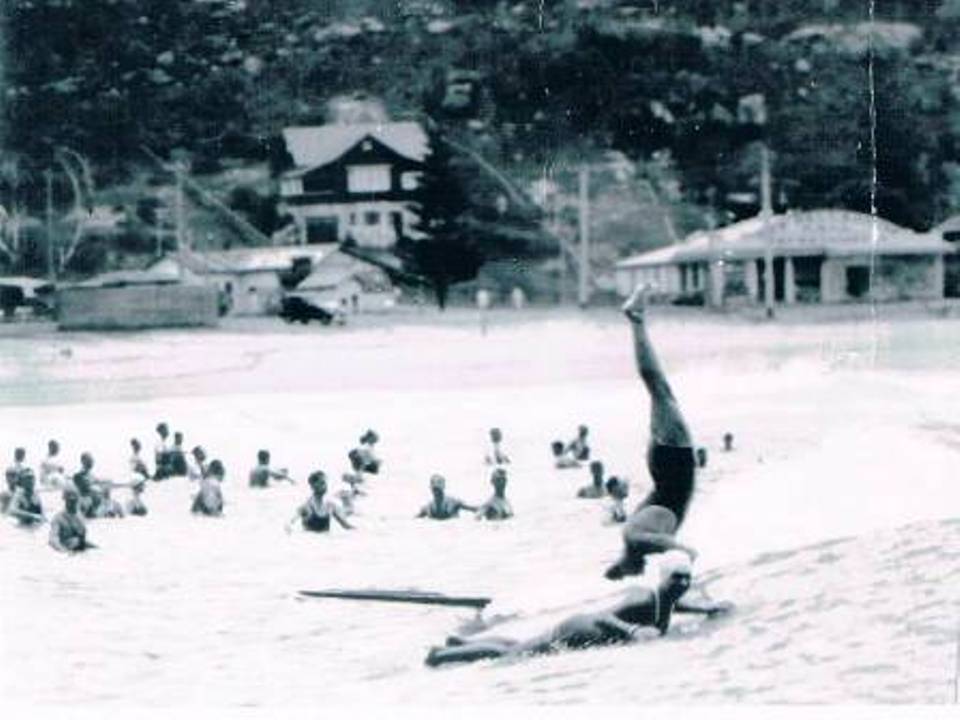

%20Tony%20Hynard%20surfboard.jpg?timestamp=1633629764832)


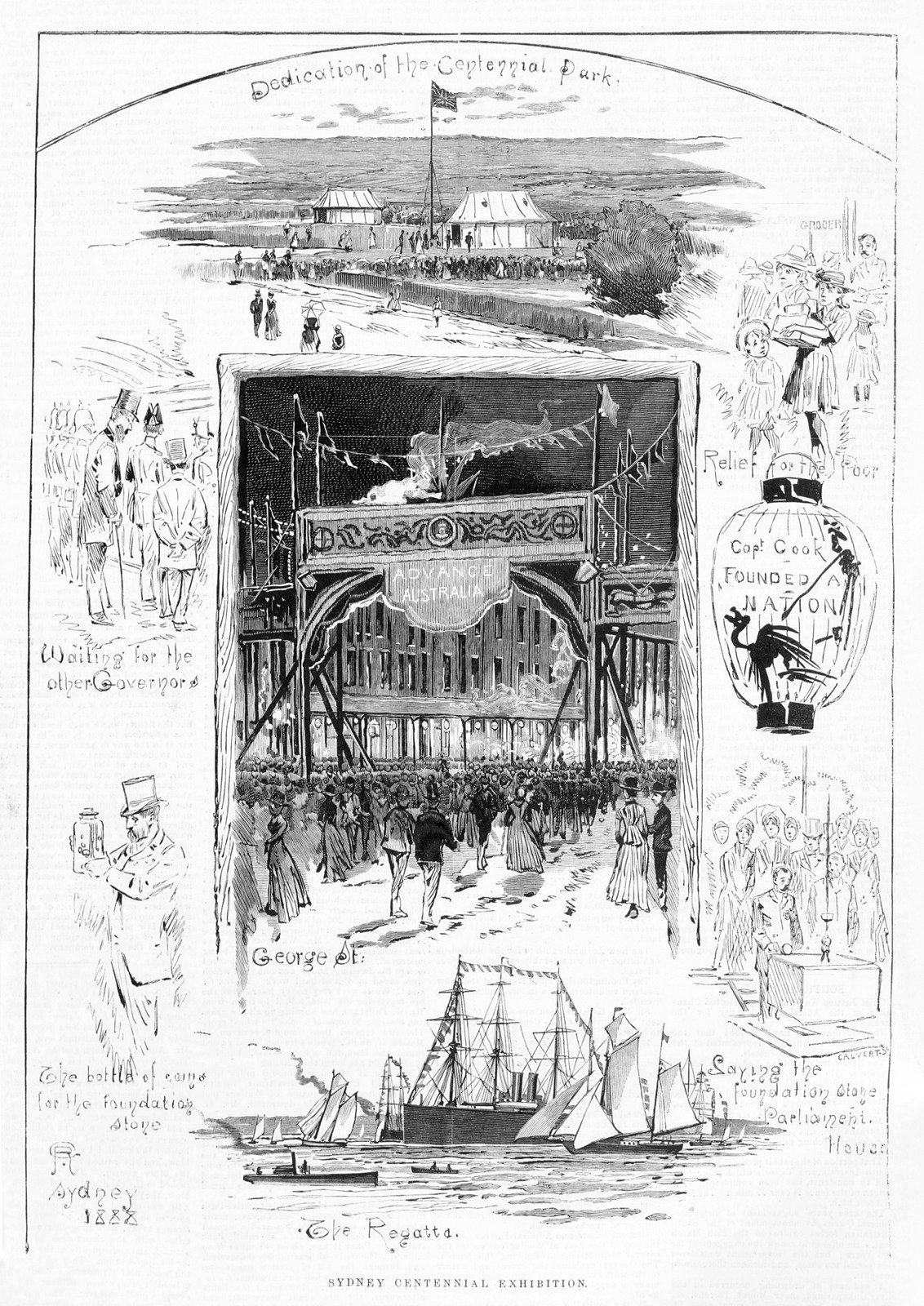
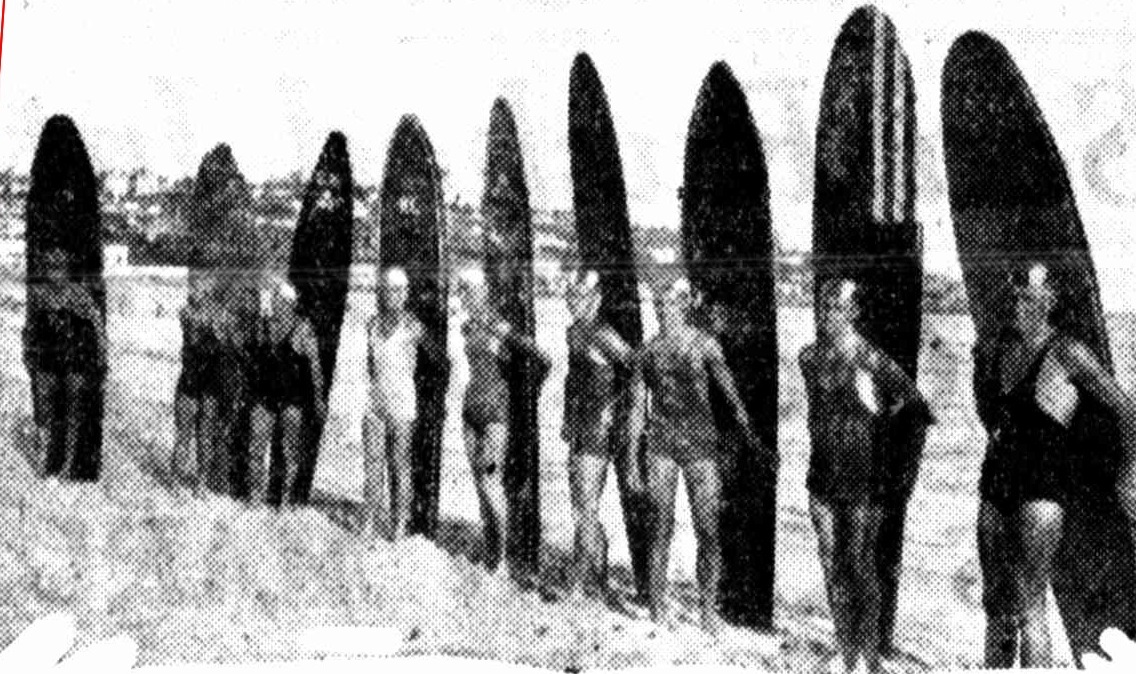
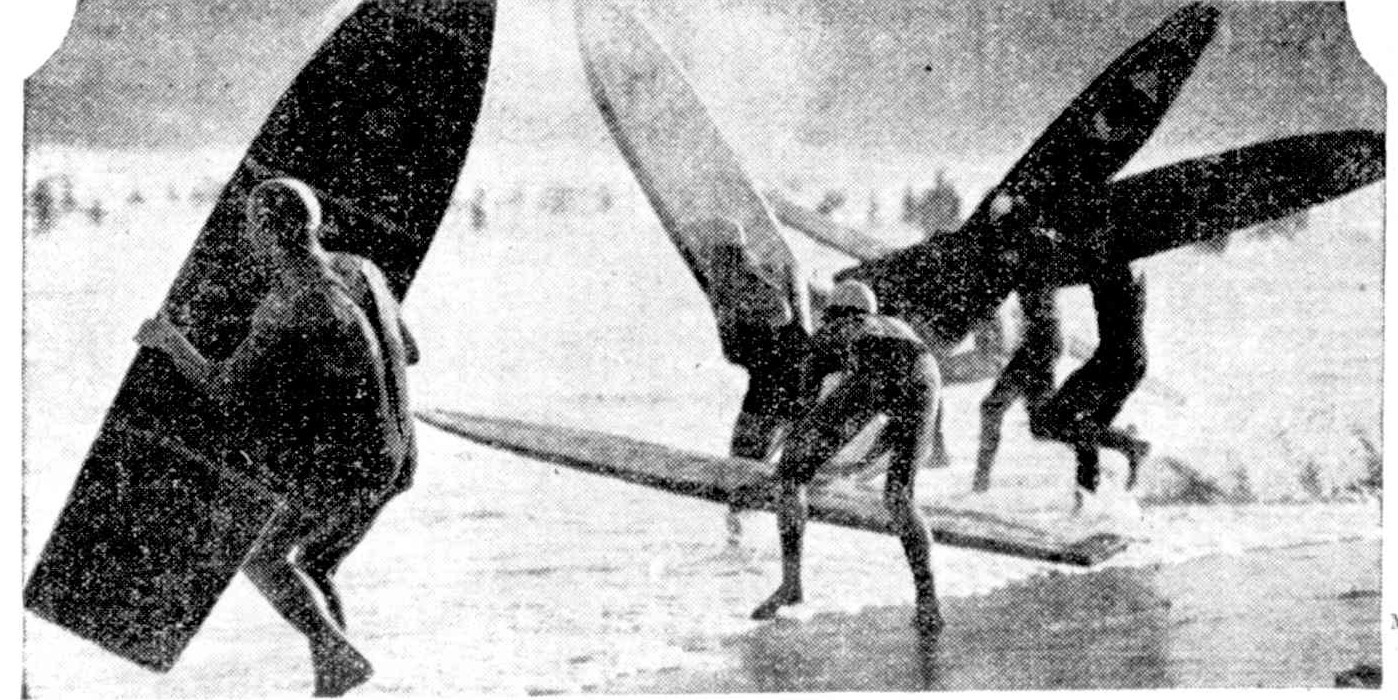
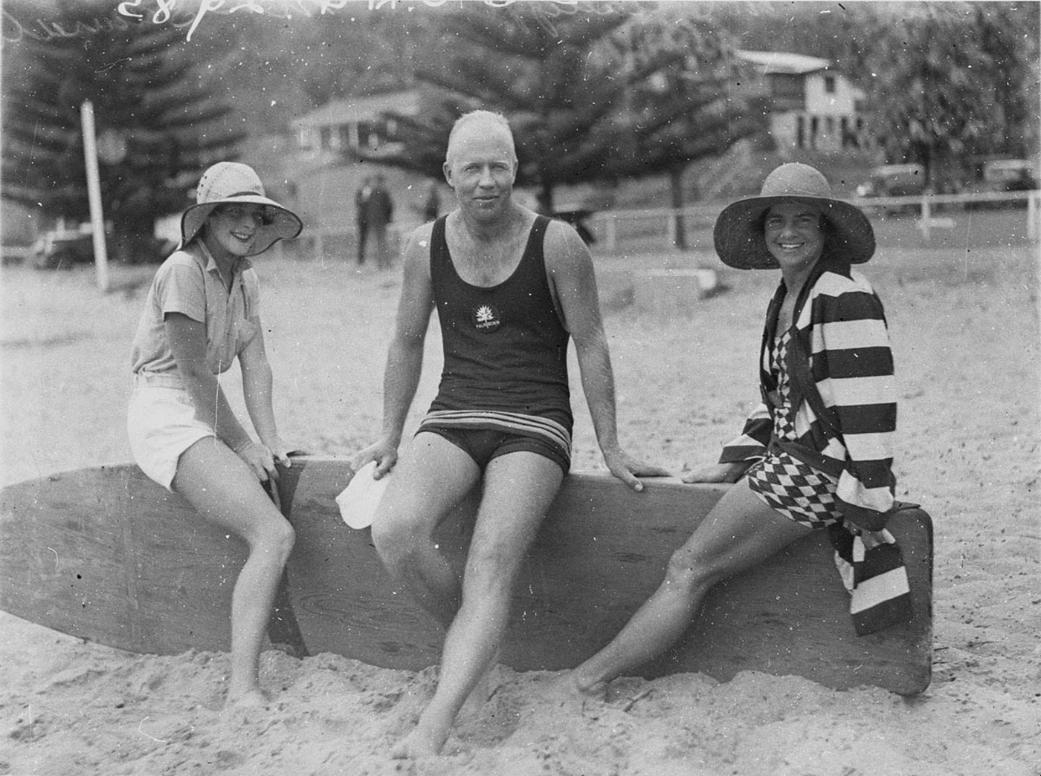
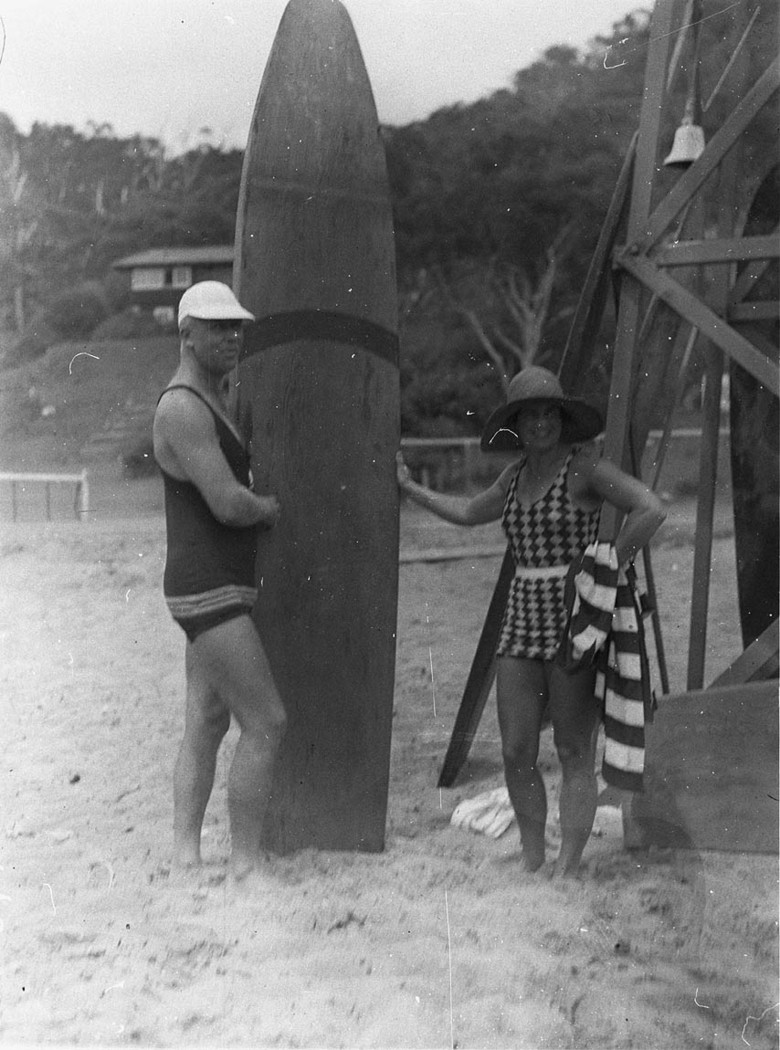
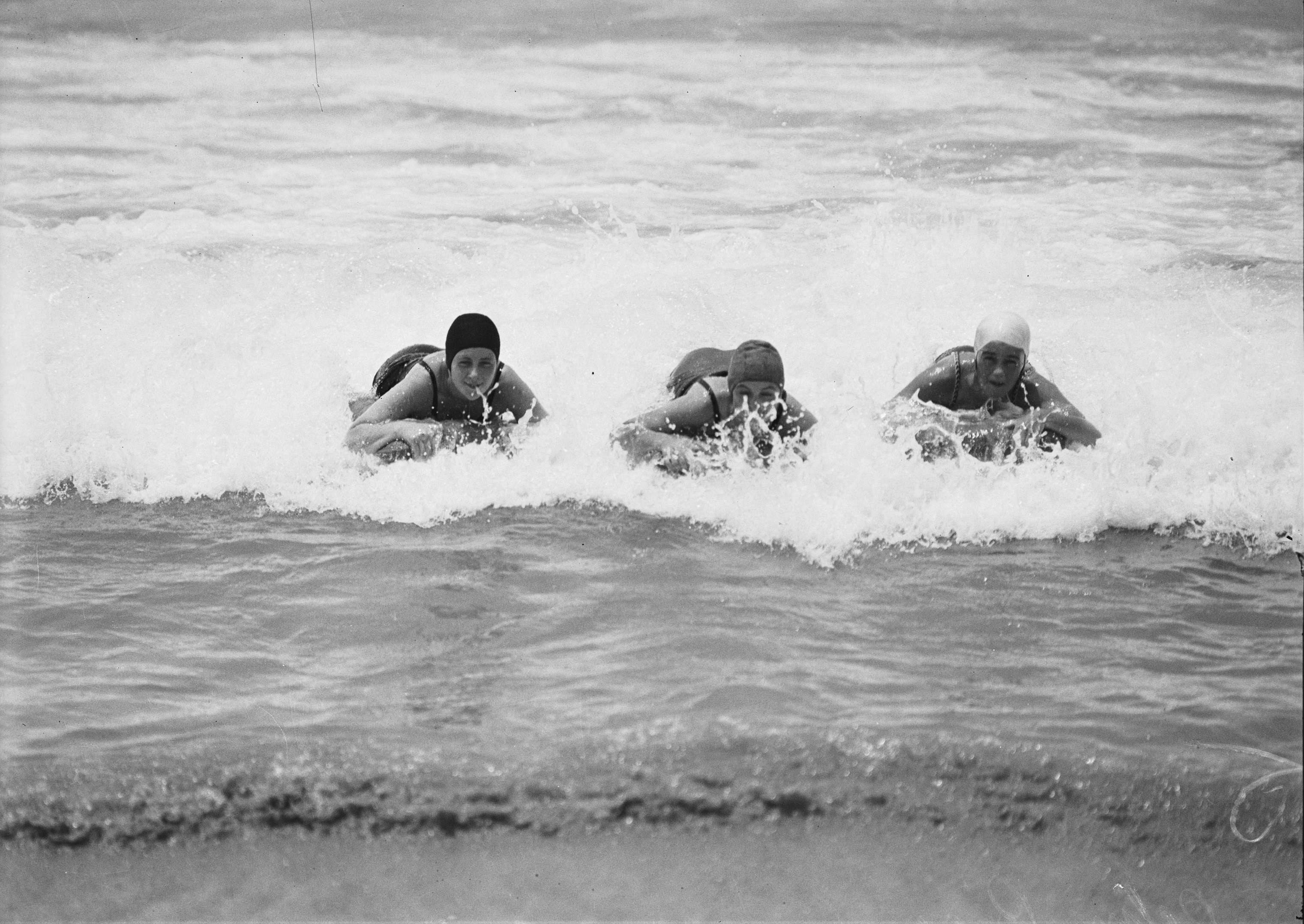
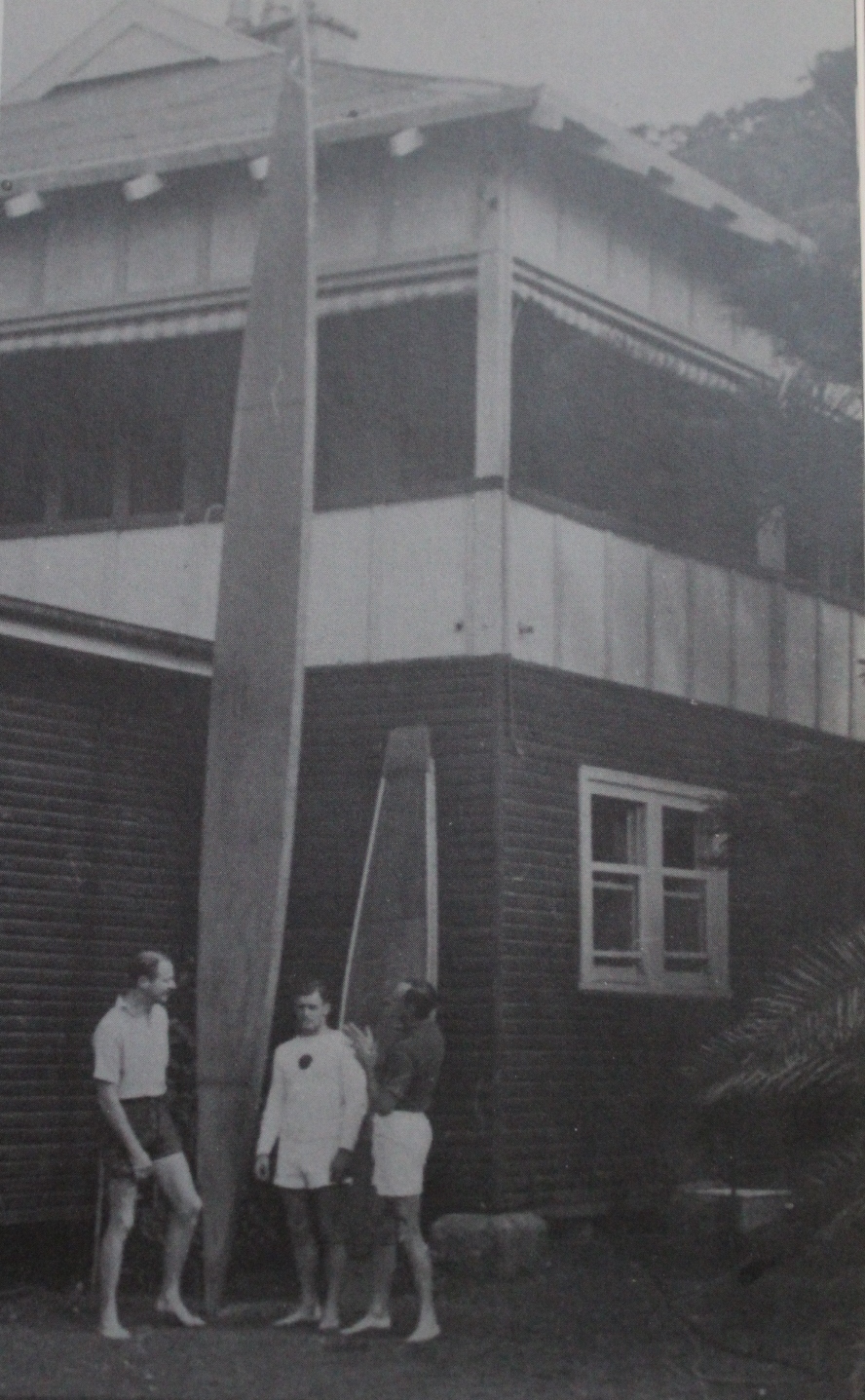

 Mrs. Dallon, wife of Commander L. S. Dallon, is in the foreground and her small boy David, is under the umbrella.
Mrs. Dallon, wife of Commander L. S. Dallon, is in the foreground and her small boy David, is under the umbrella. 